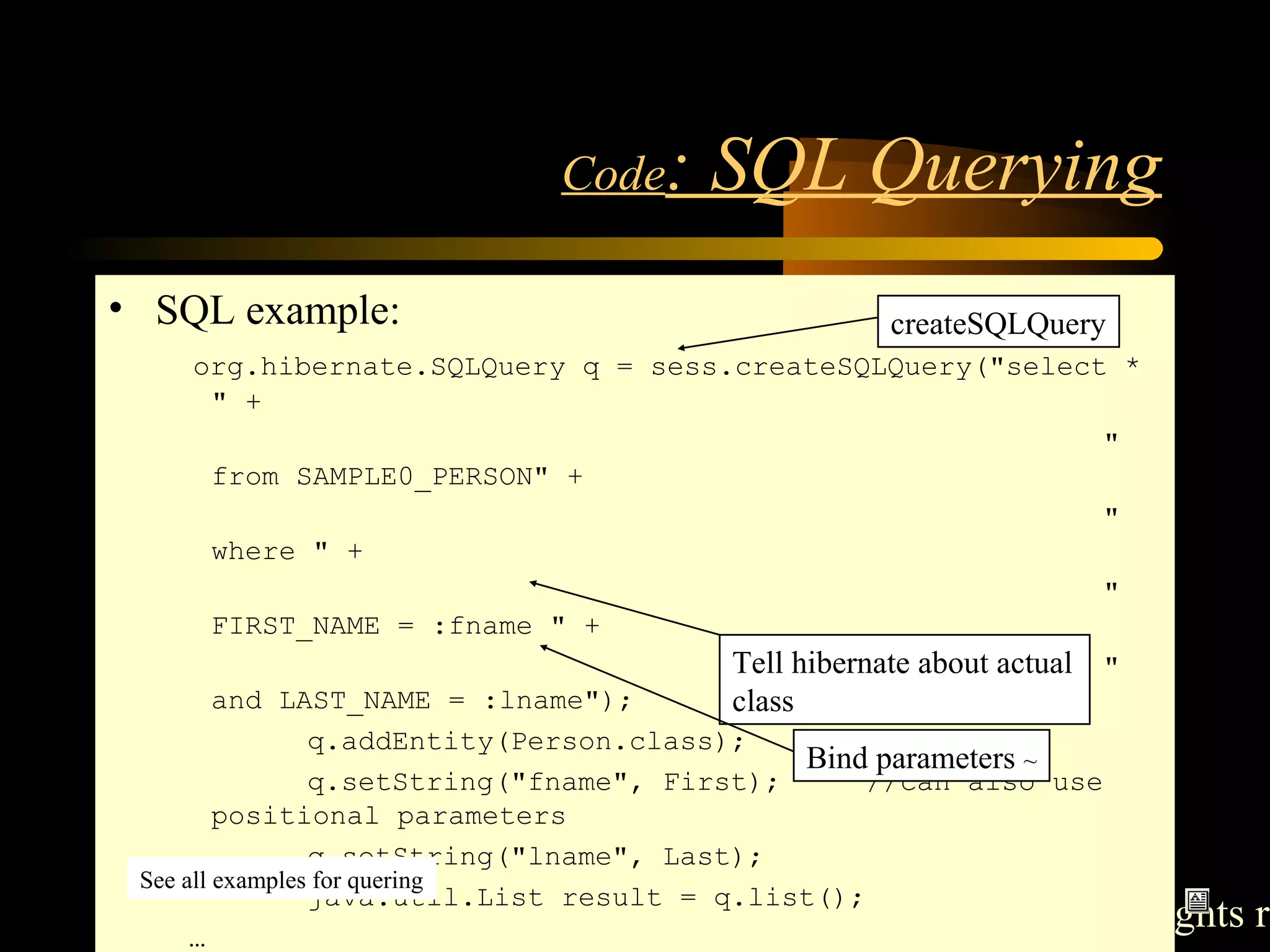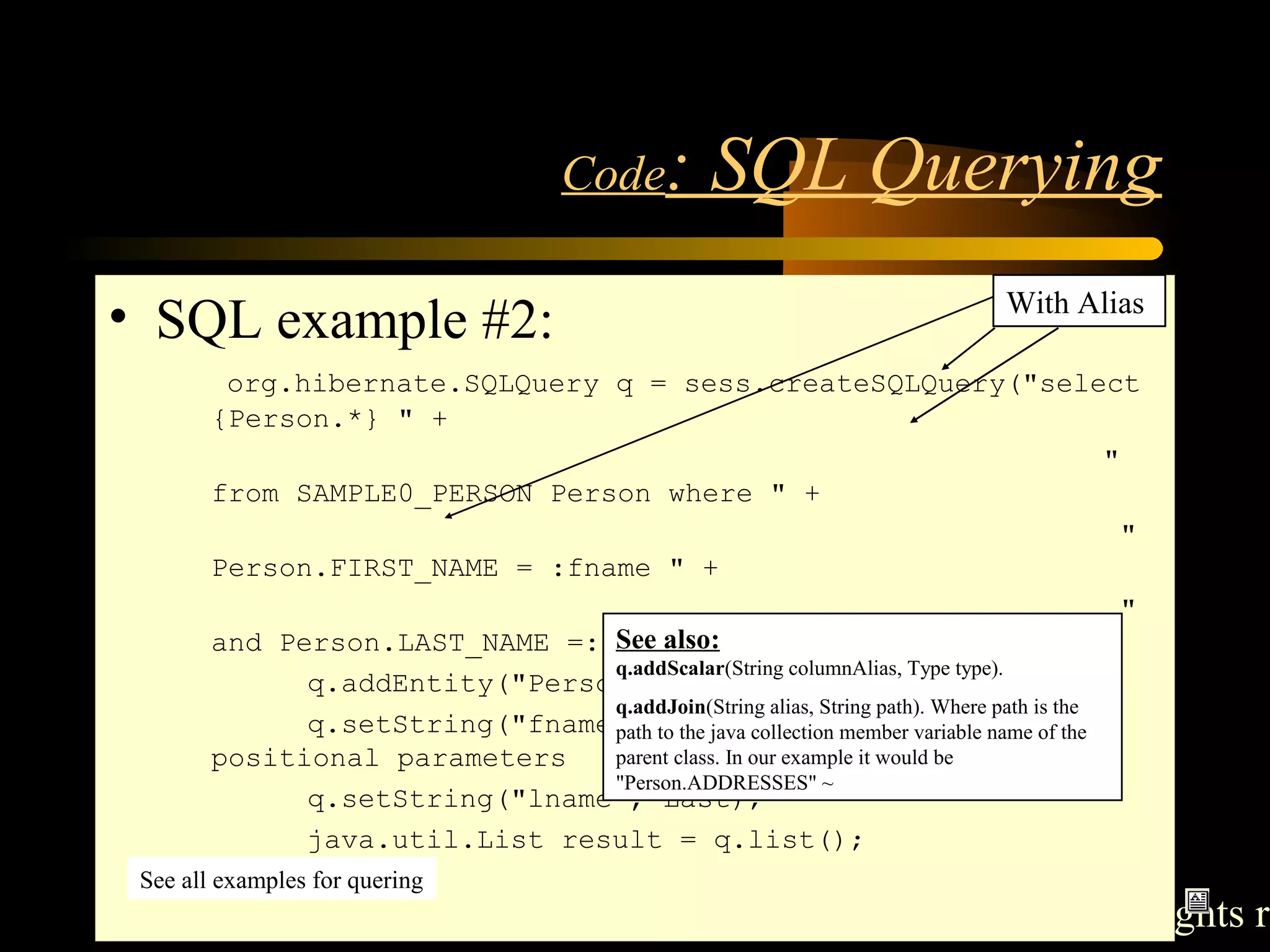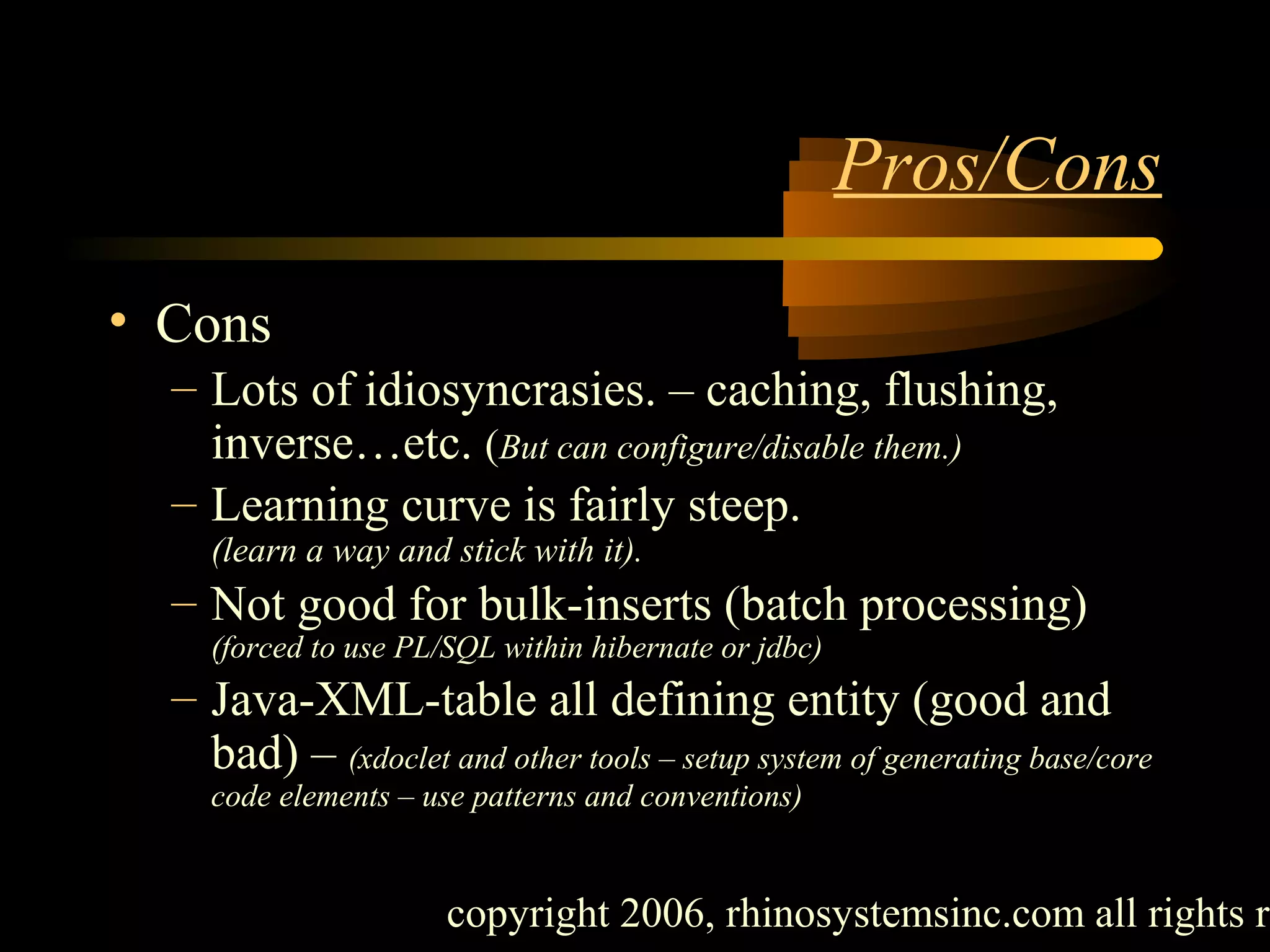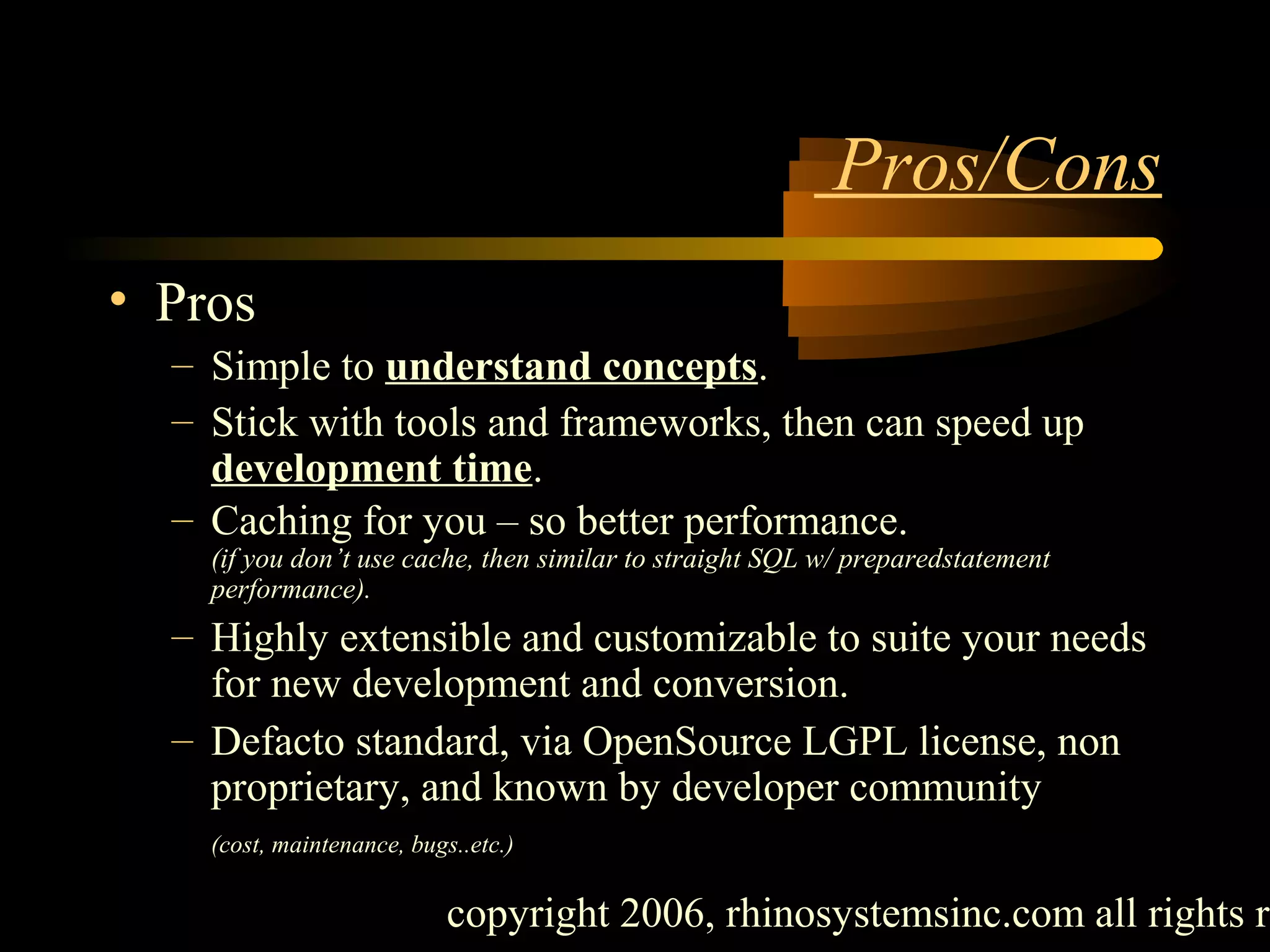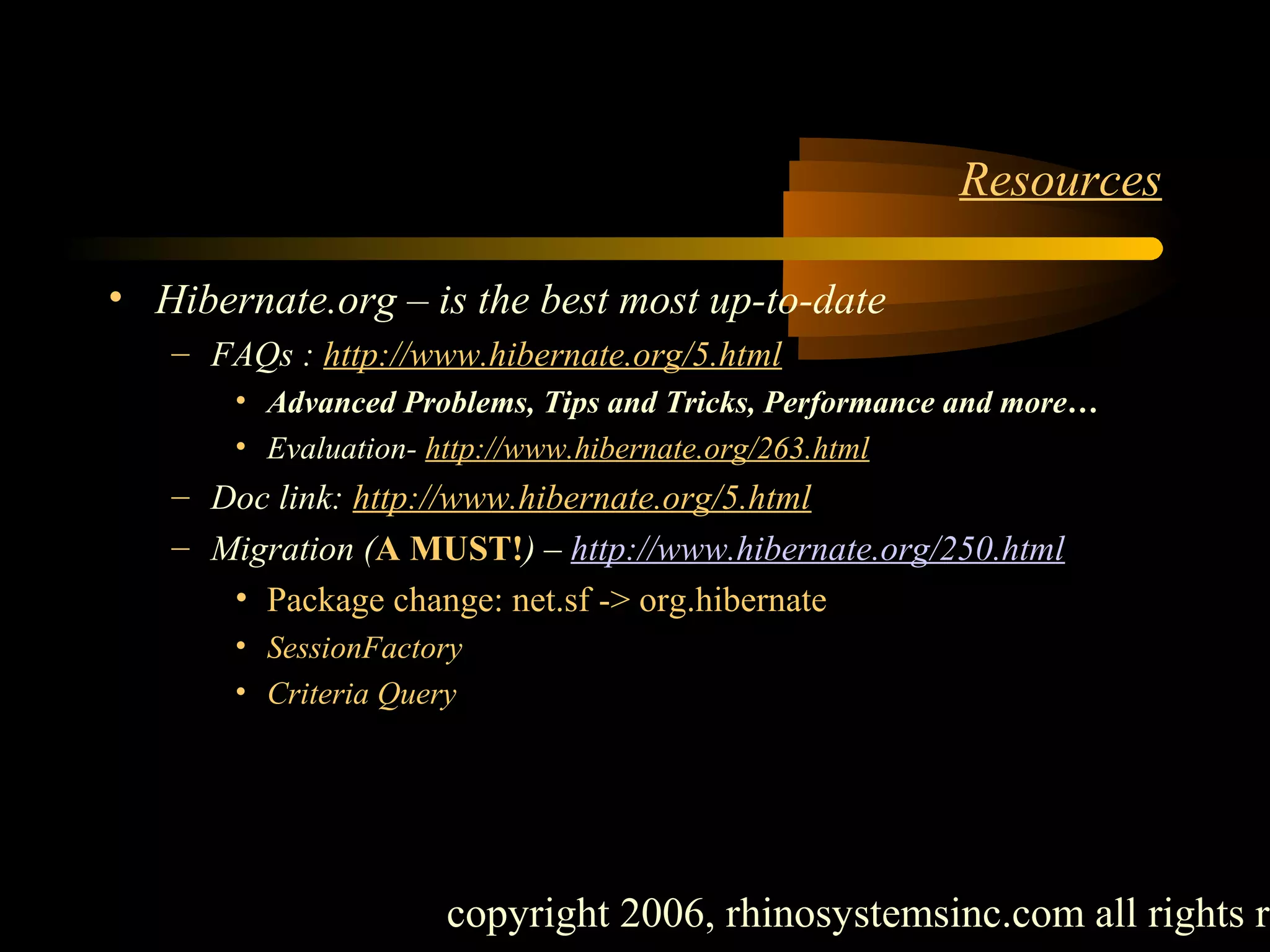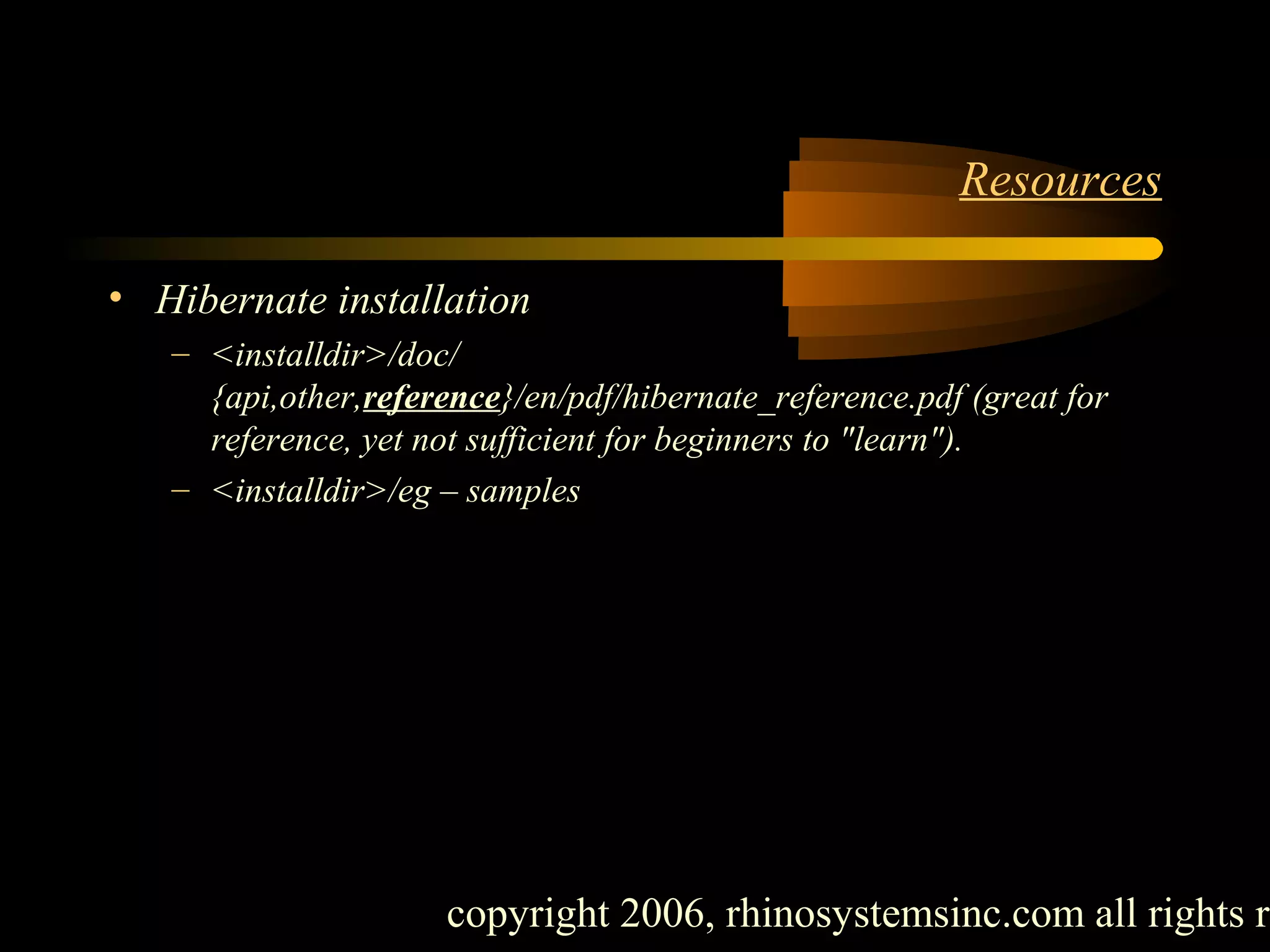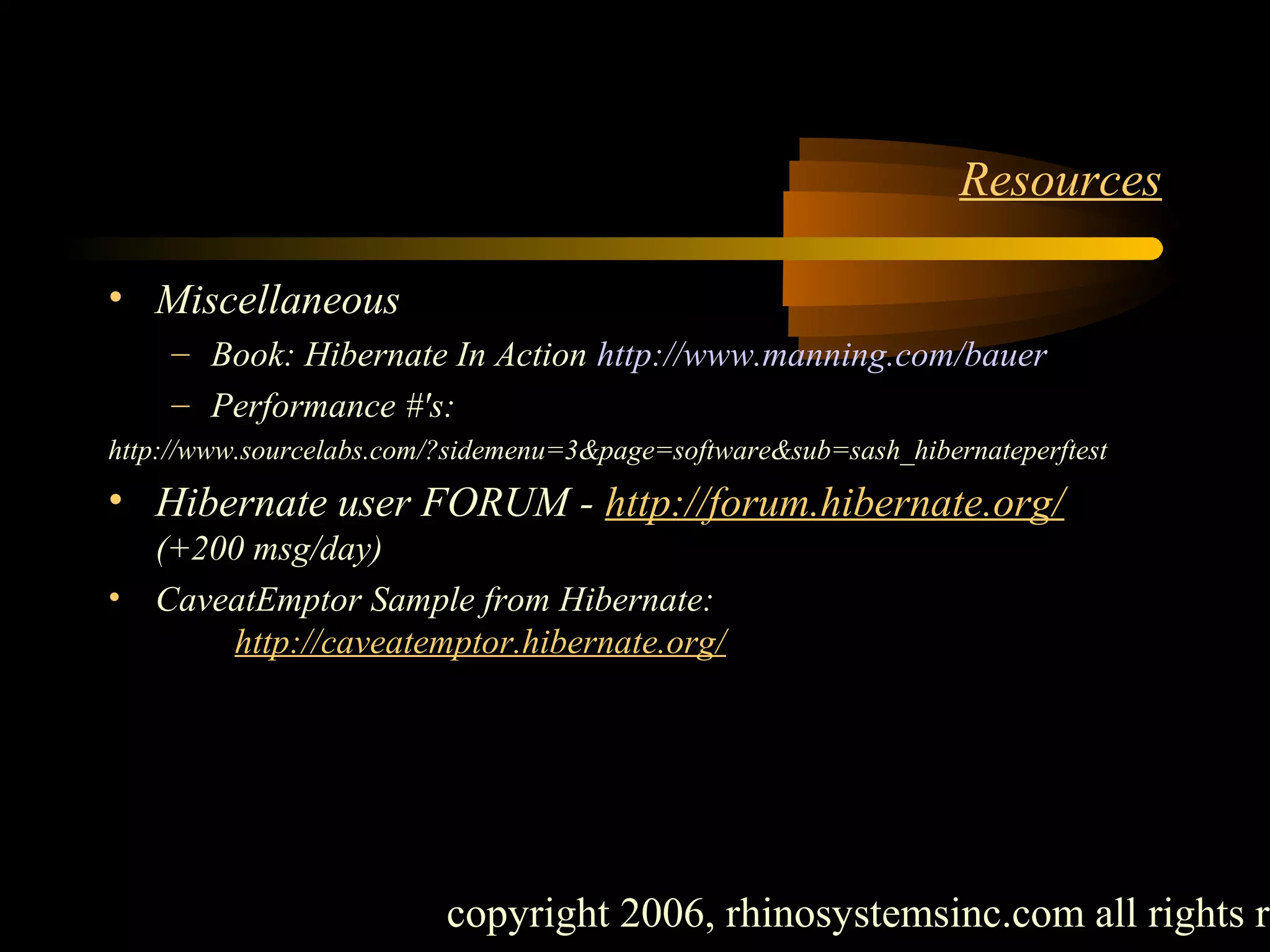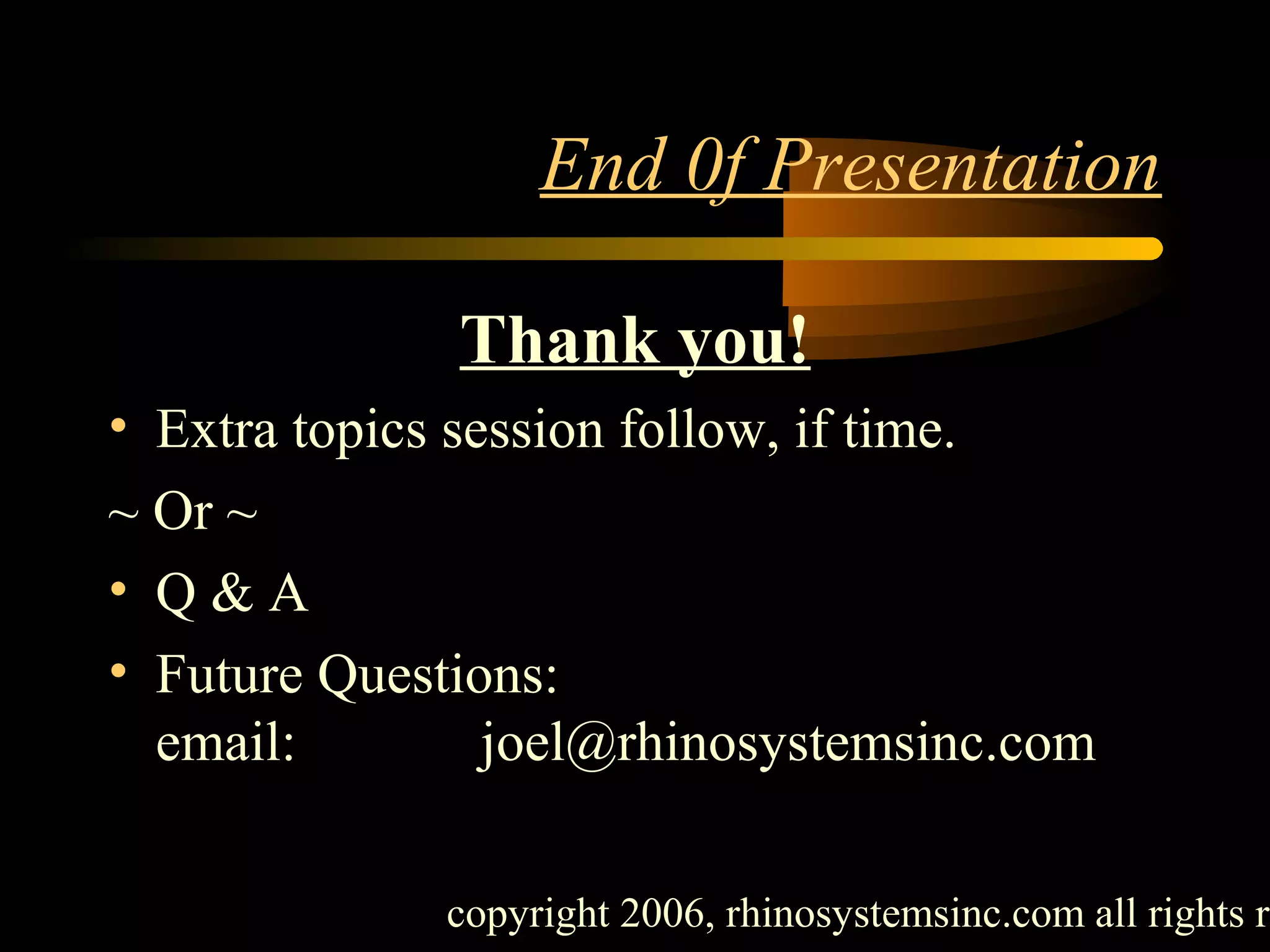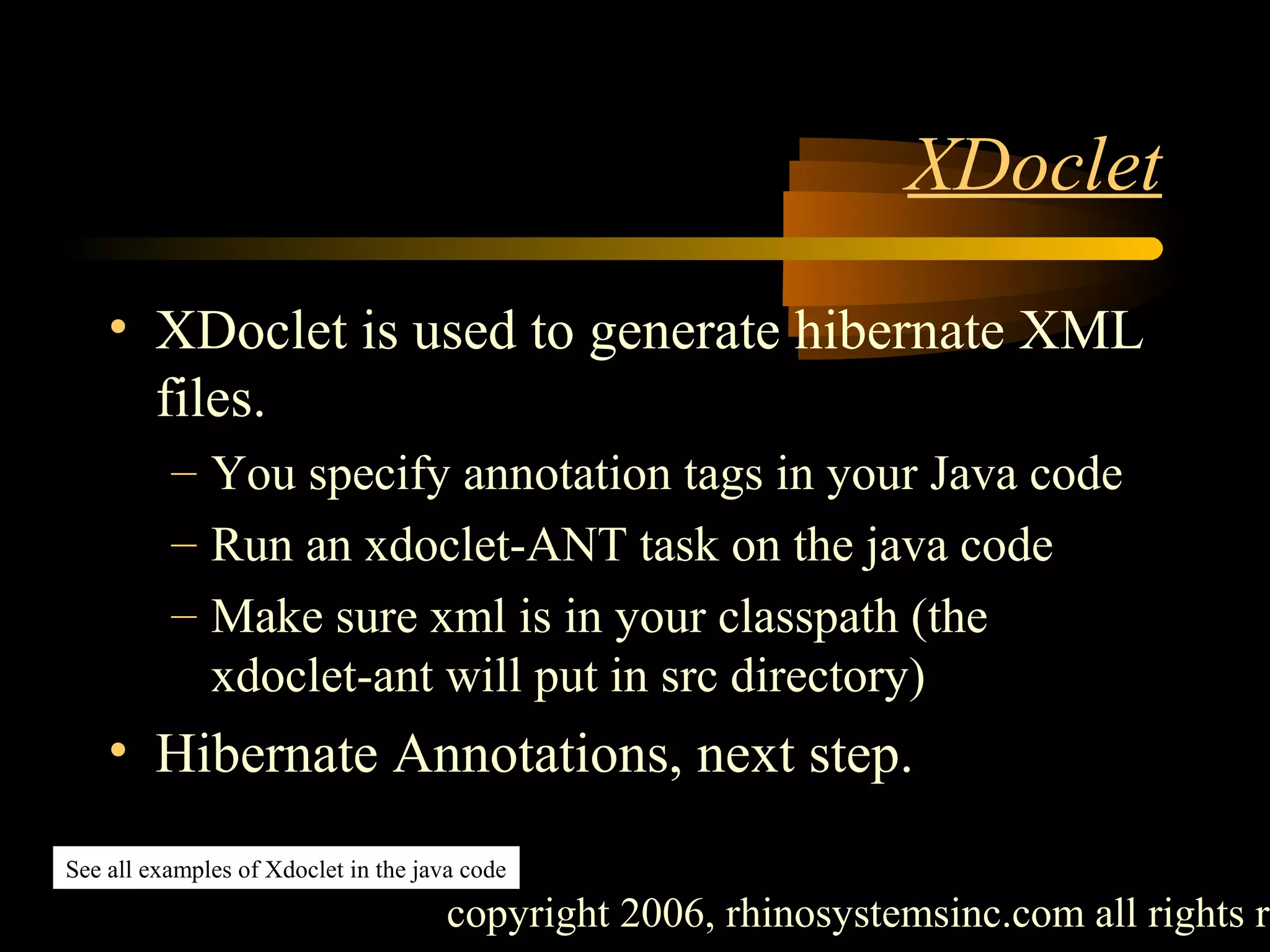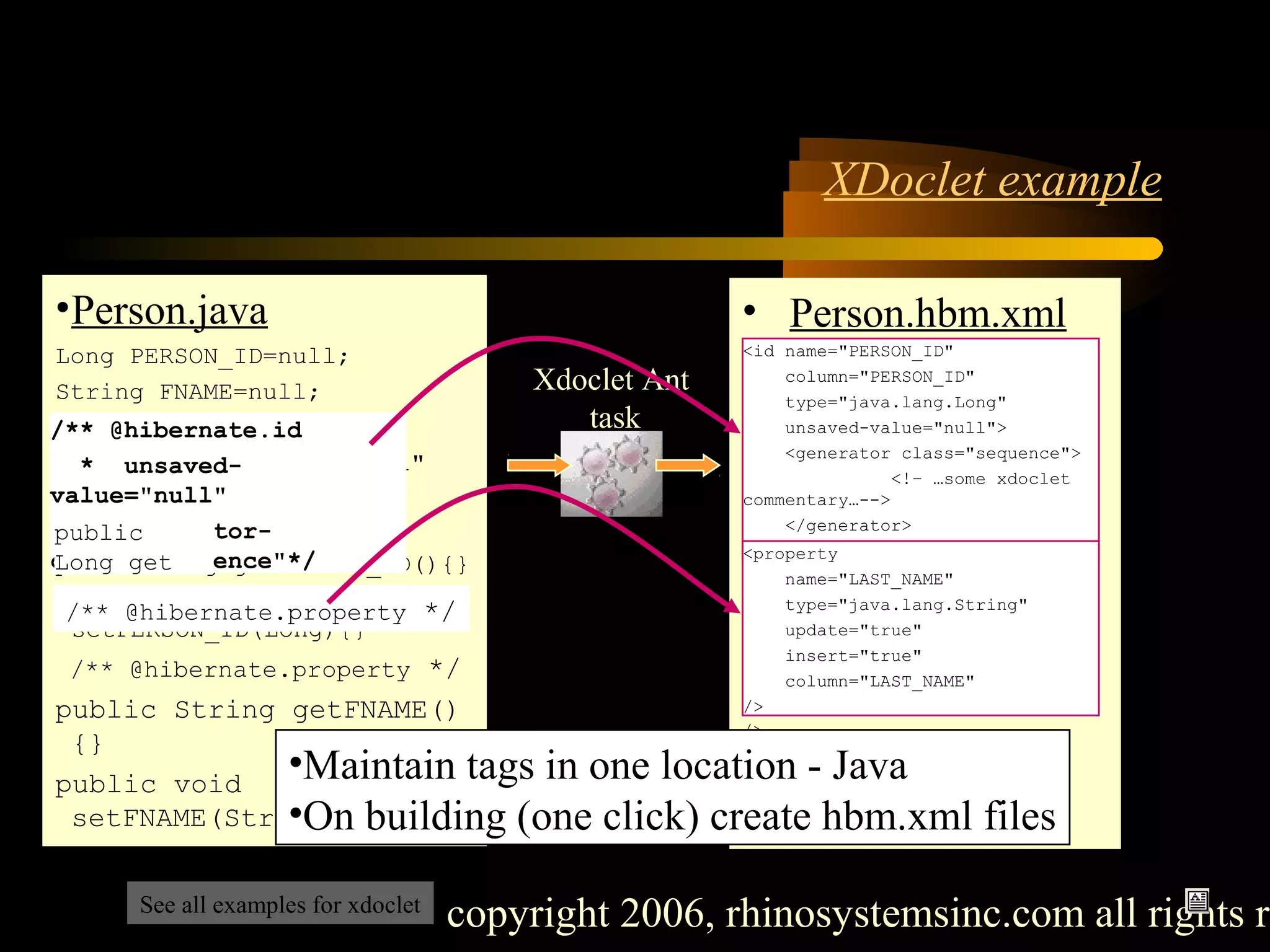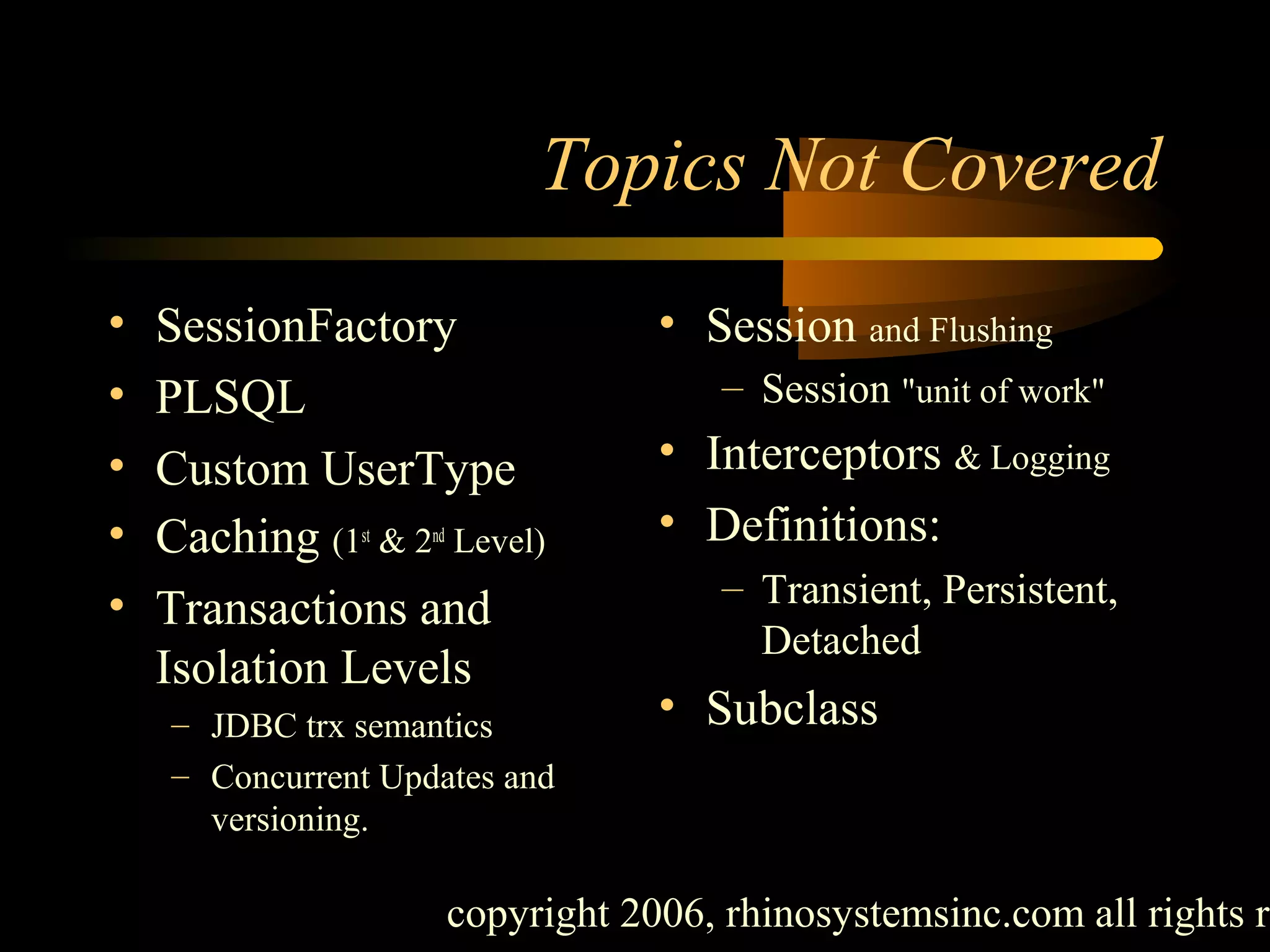The document provides an overview of configuring and using Hibernate, an object-relational mapping tool for Java. It discusses downloading and setting up required libraries, configuring Hibernate properties and mappings, and examples of mapping Java objects to database tables for single entities, primary keys, one-to-many and many-to-many relationships, and reference data. Code samples and explanations are provided for saving, updating, and querying objects using Hibernate.
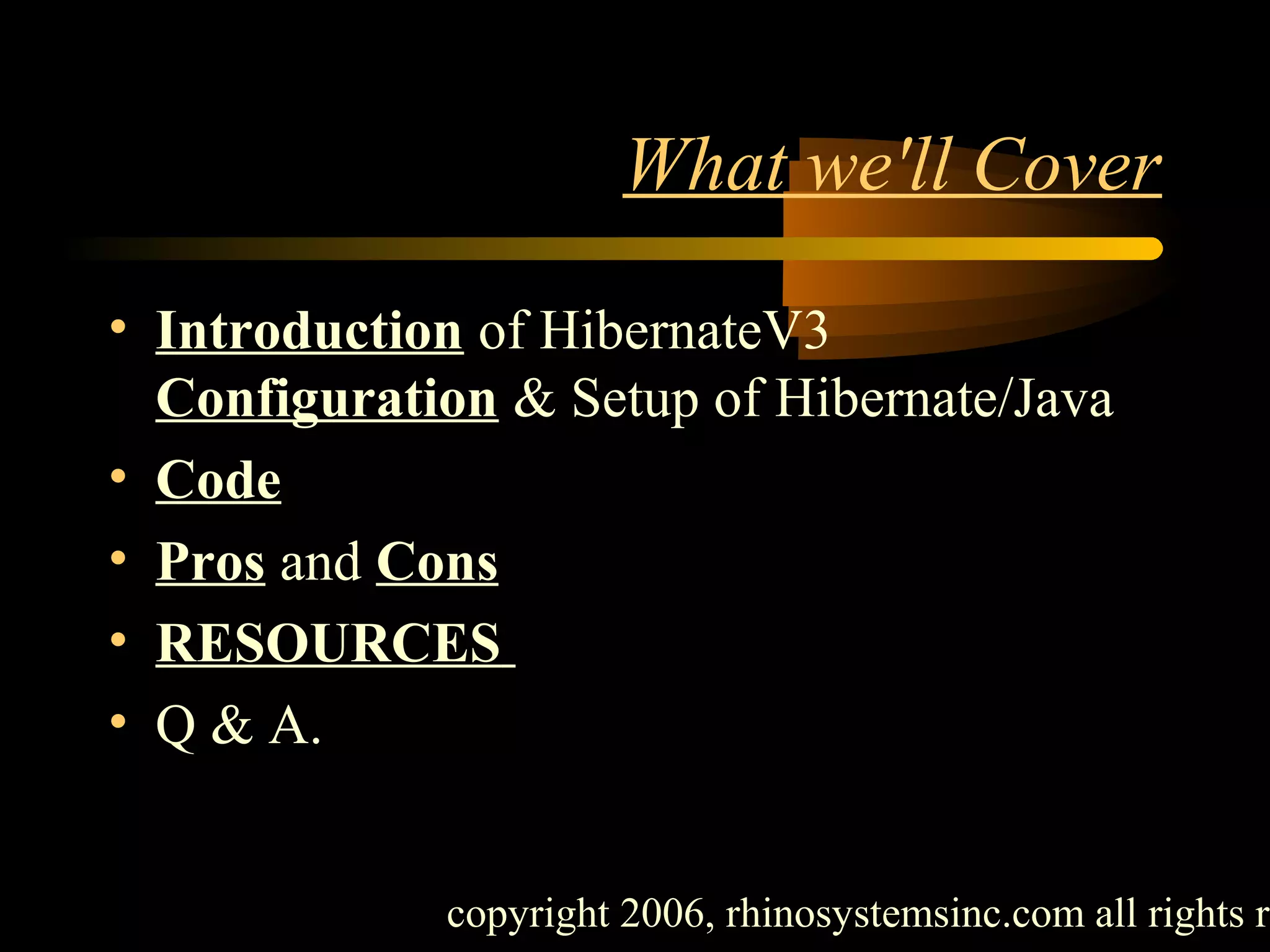
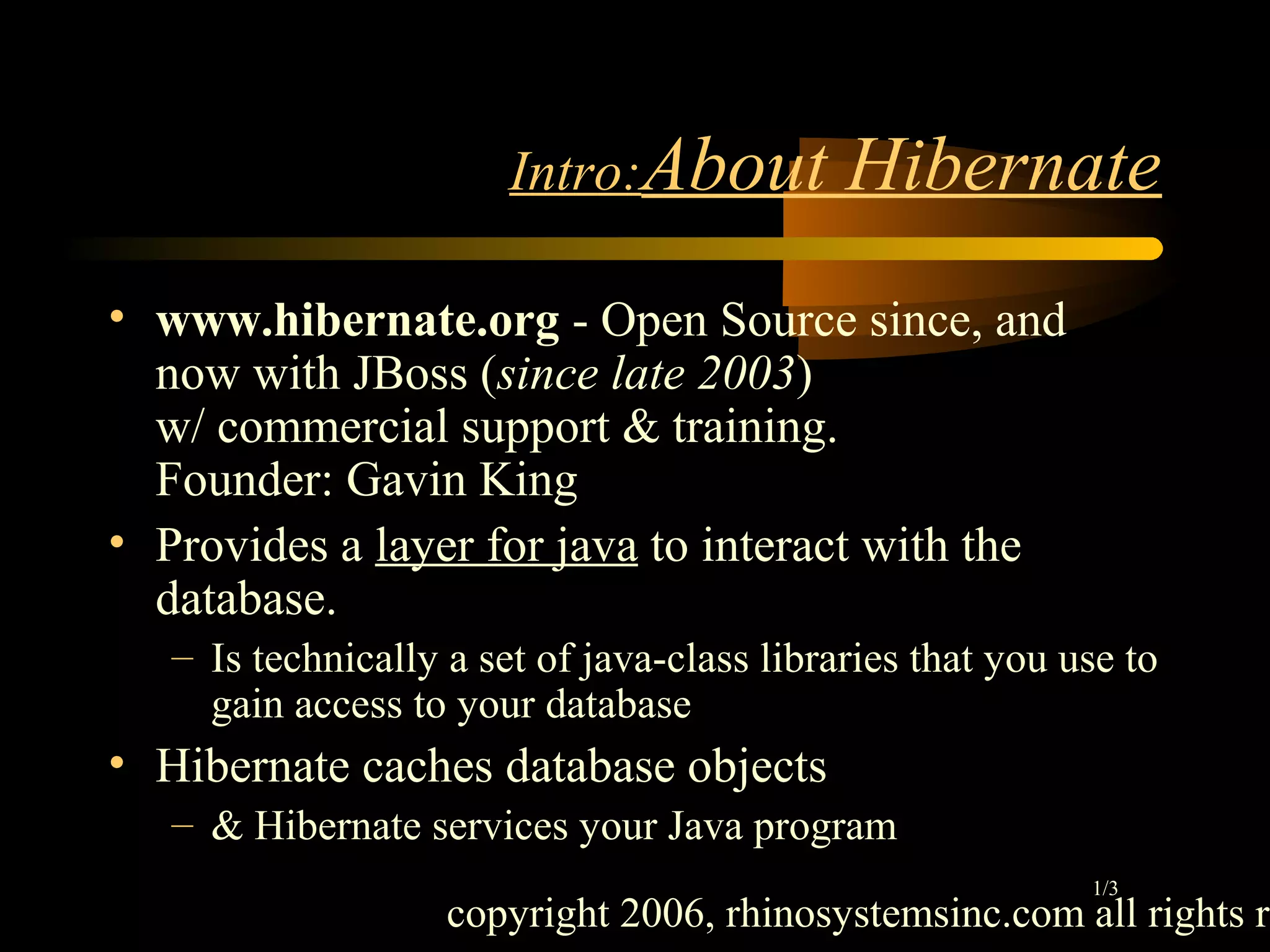
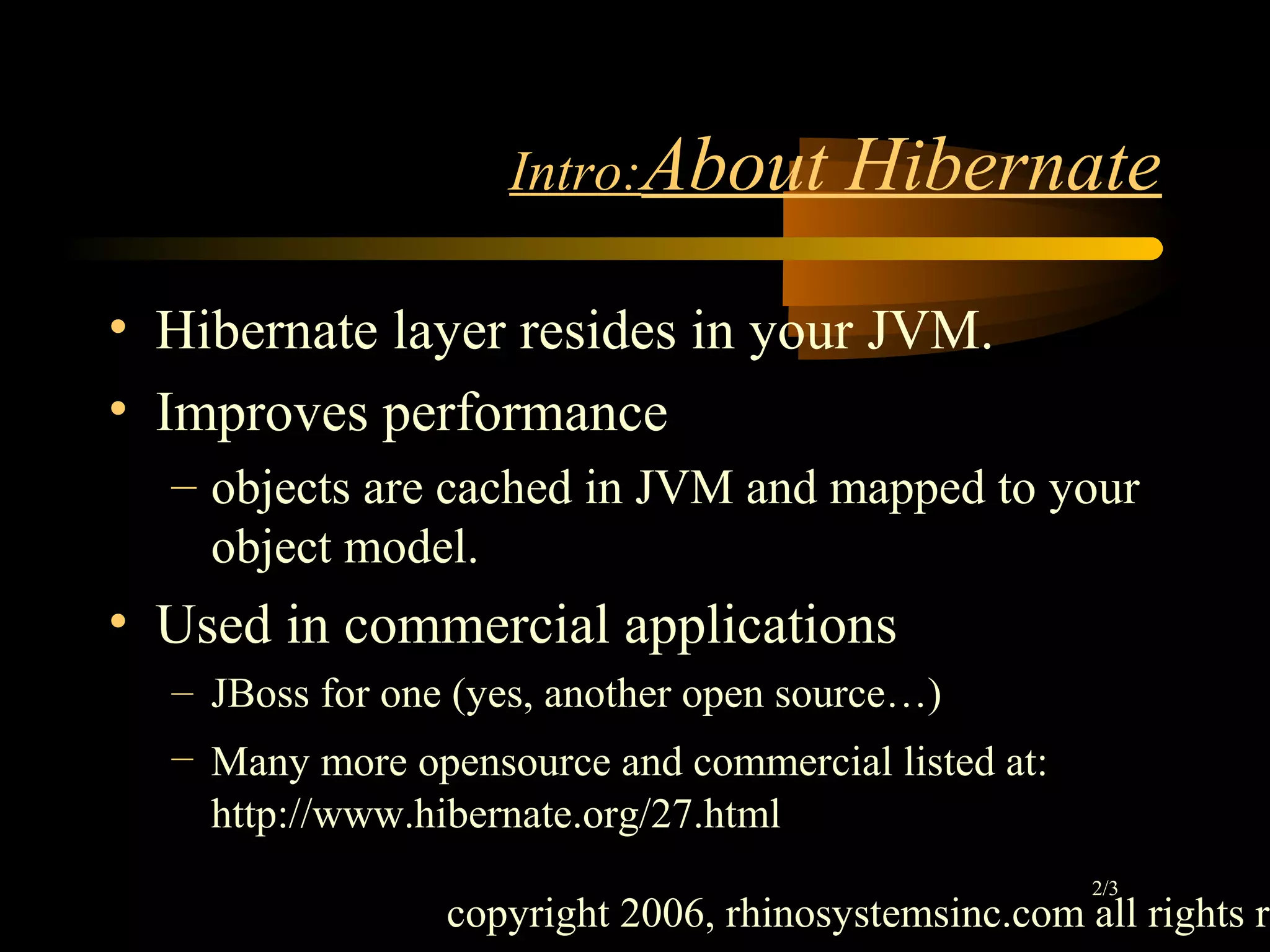
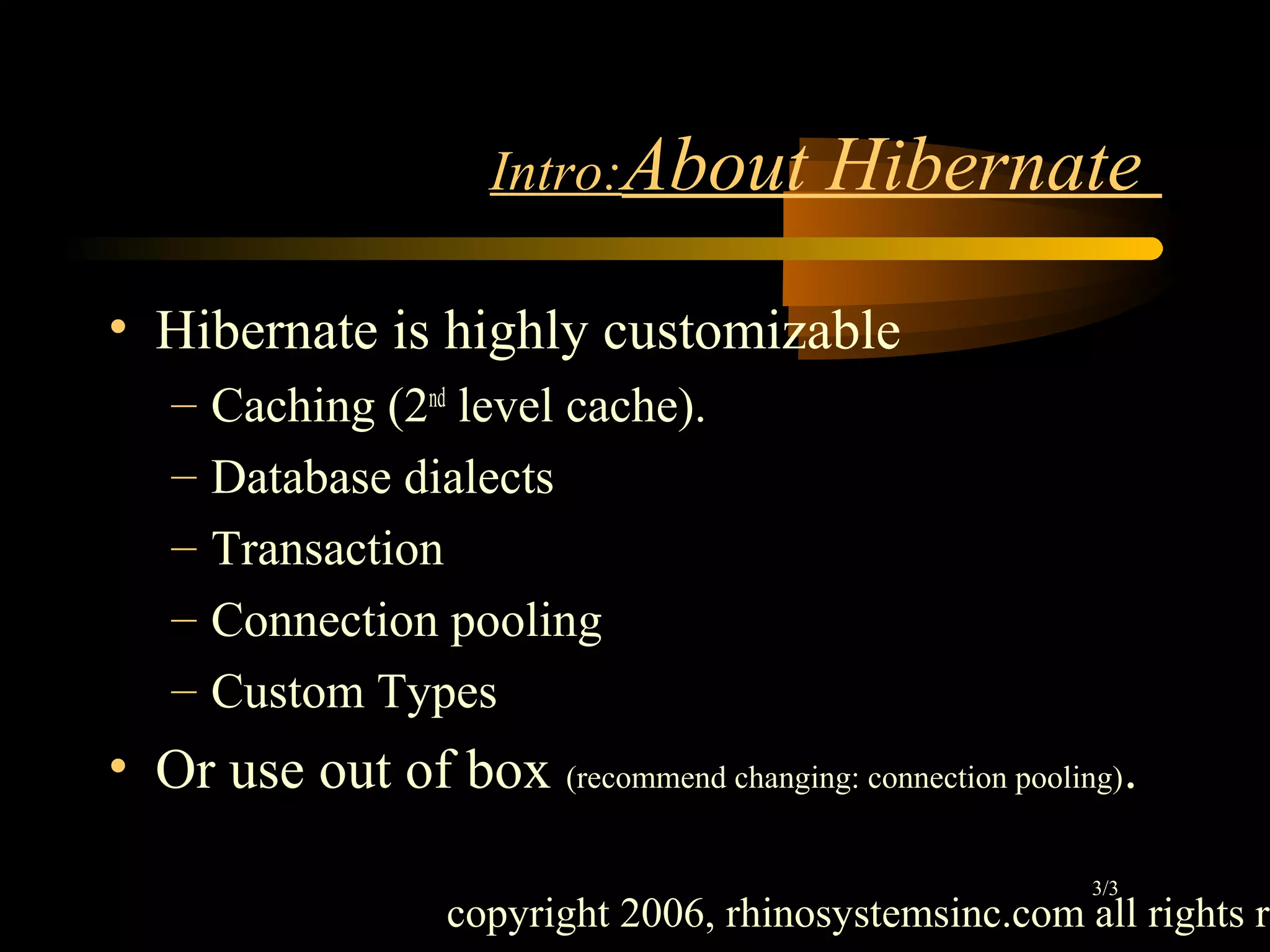
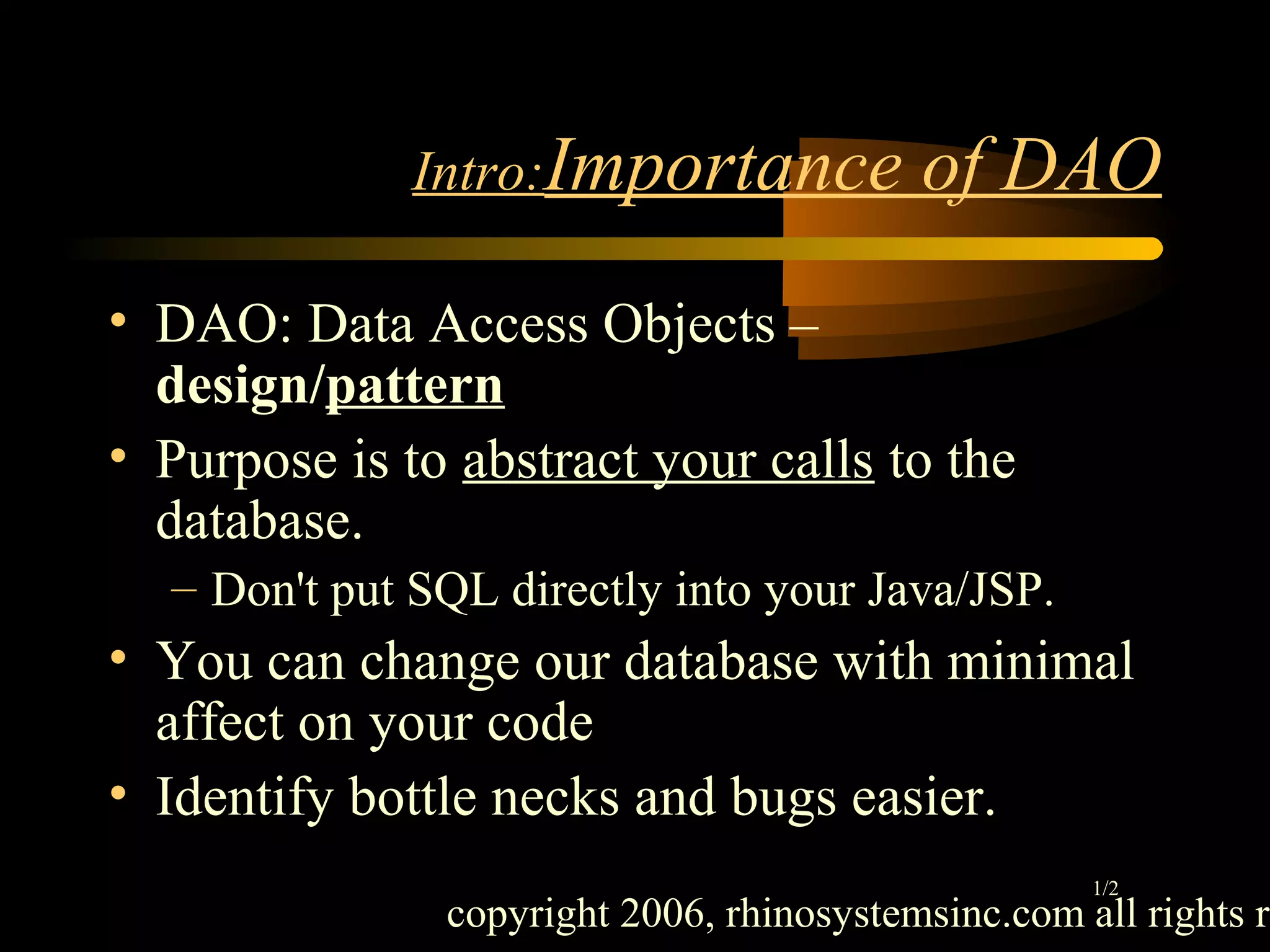
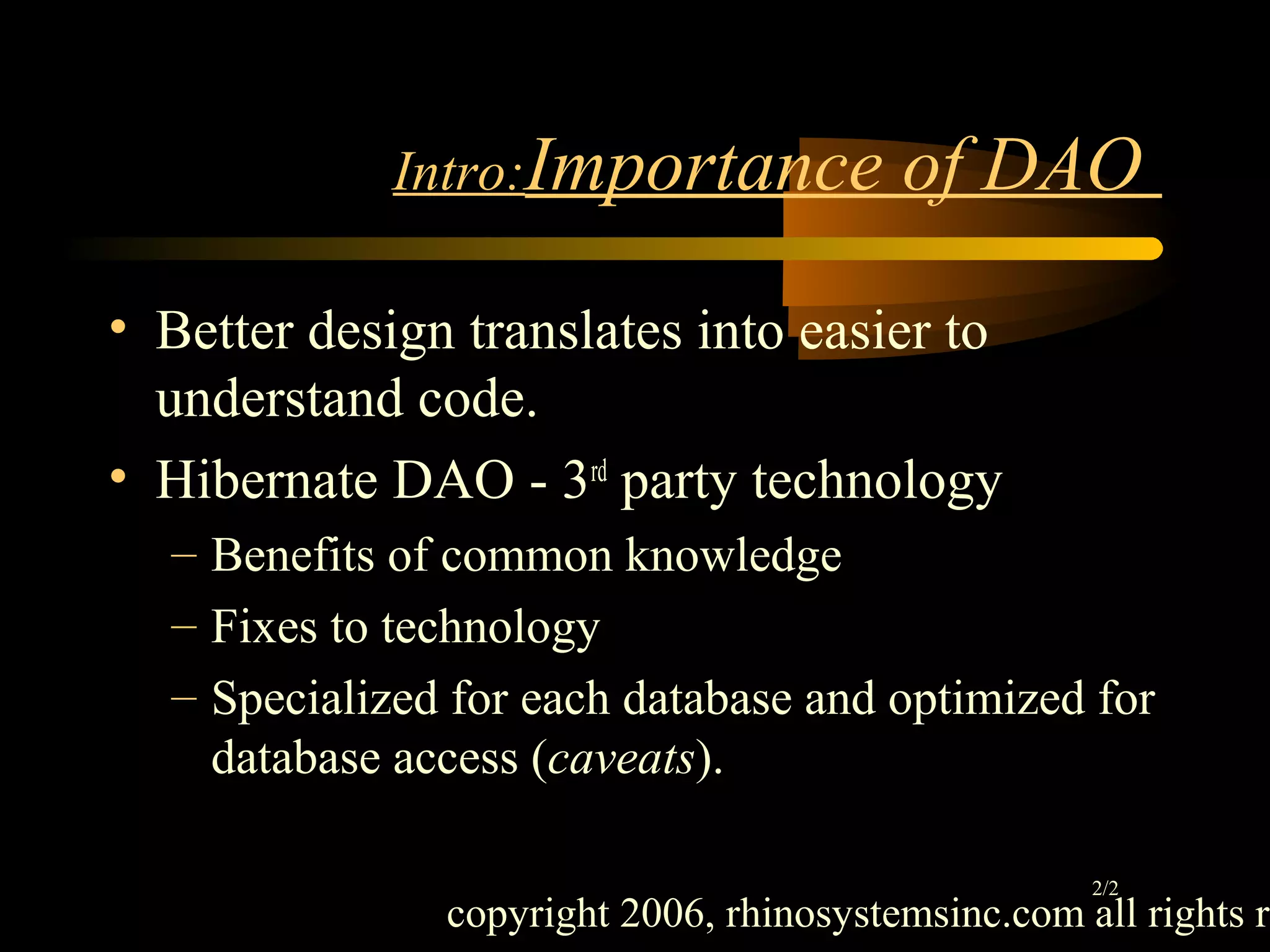
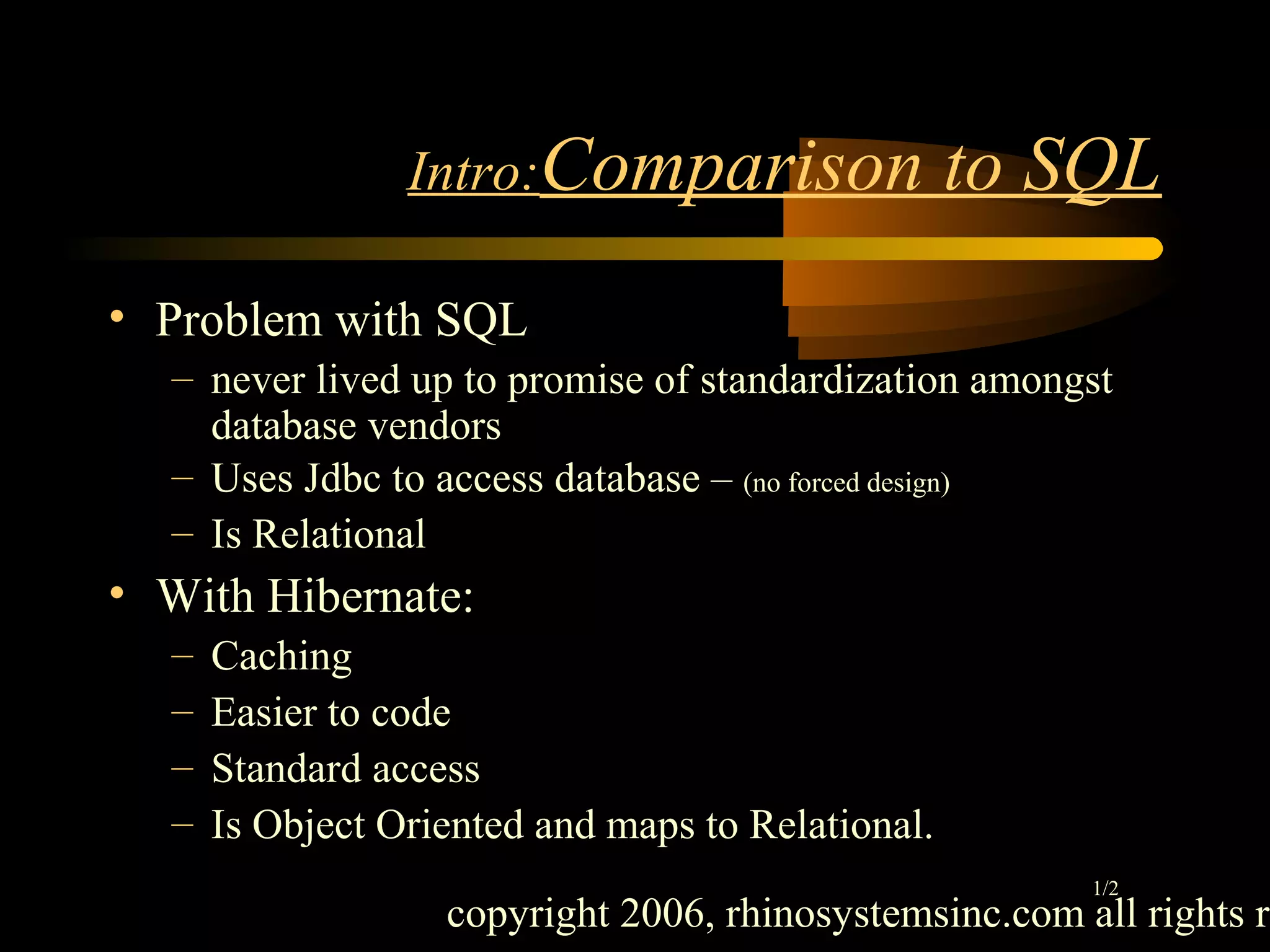
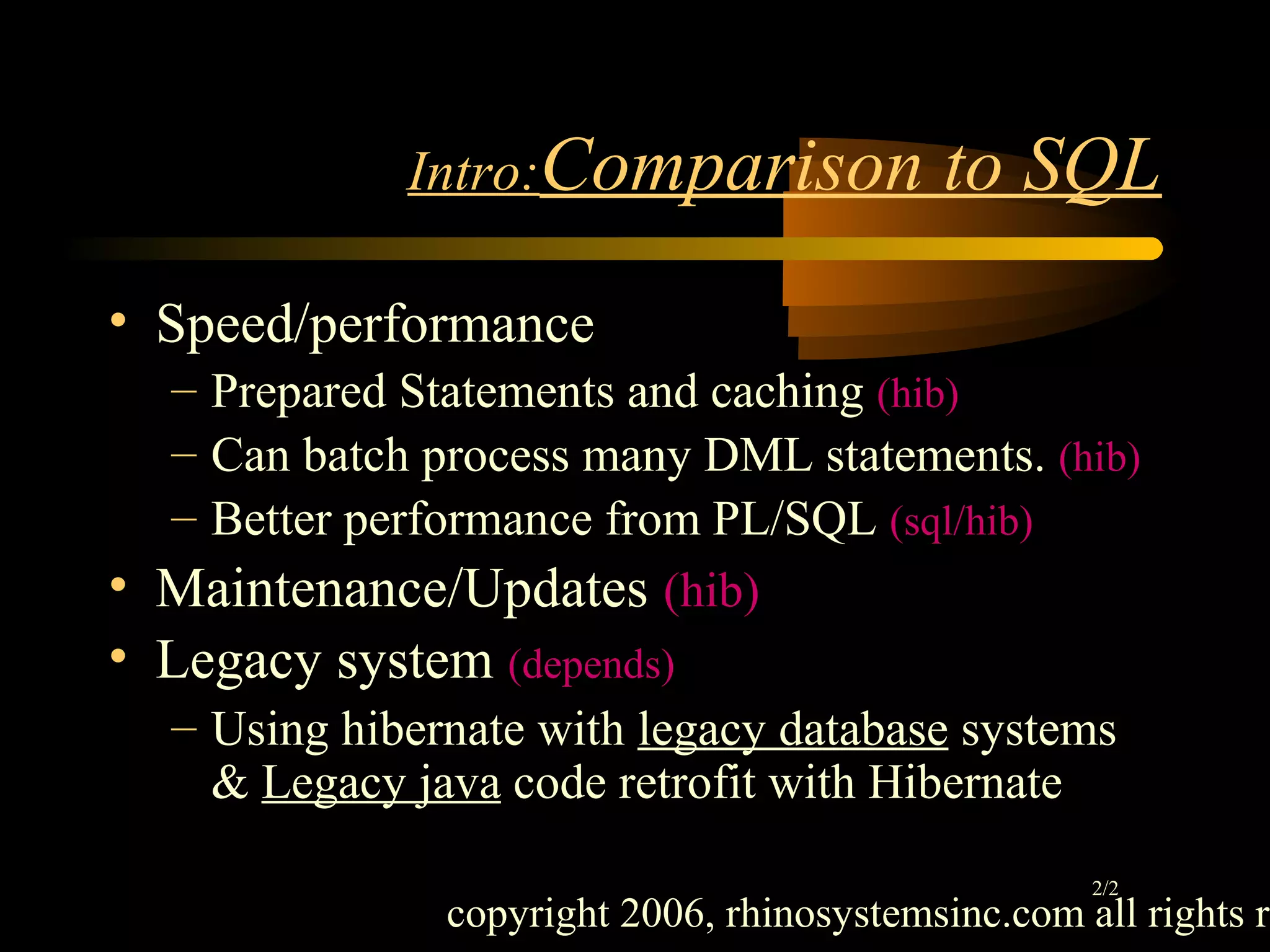
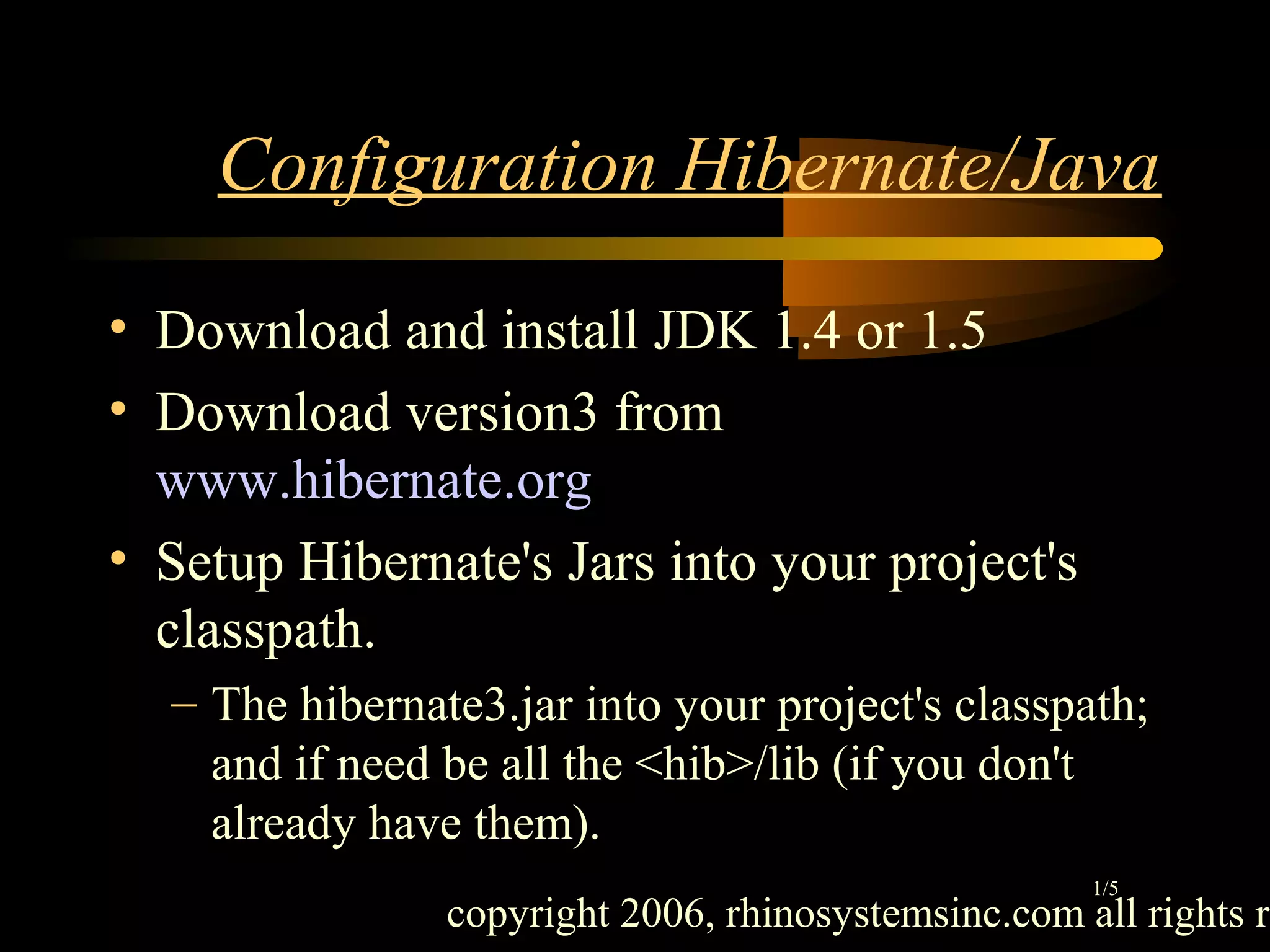
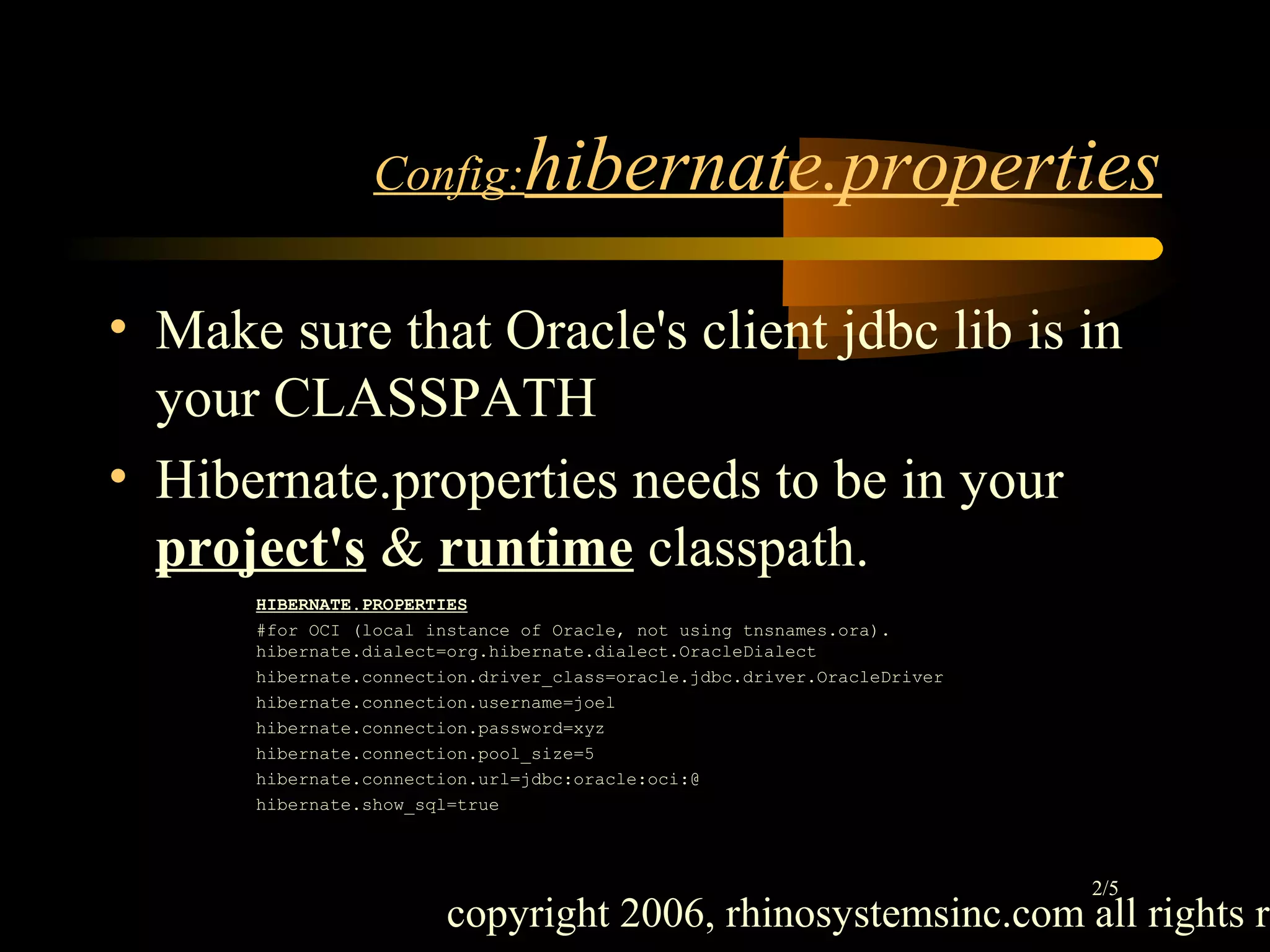
![copyright 2006, rhinosystemsinc.com all rights re
Config: Download & Config
Xdoclet
[OPTIONAL]
• In order to run the "generation" of hibernate
XML you need to setup your classpath to include
Xdoclet libraries
• Download latest (v1.2.3) from
http://xdoclet.sourceforge.net/xdoclet/index.html
(www.xdoclet.org?)
– Download direct from
http://sourceforge.net/project/showfiles.php?group_id=31602
– Tag References
http://xdoclet.sourceforge.net/xdoclet/tags/hibernate-tags.html
3/5](https://image.slidesharecdn.com/hibernatejavaandoracle1-151018162037-lva1-app6892/75/Hibernate-java-and_oracle-11-2048.jpg)
![copyright 2006, rhinosystemsinc.com all rights re
config: Download & Config ANT
[OPTIONAL]
• In order to use ANT you'll need to setup your
PATH to include ANT. Check – run "ant"
• Download latest (v1.6.5) from http://ant.apache.org/
(www.ant.org?)
– Download direct from
http://www.axint.net/apache/ant/binaries/apache-ant-1.6.5-bin.zip
– Unzip and make sure "ant" is in your path. (right-click my computer ->
properties ->Advanced->Environmental Variables -> update PATH with directory
<ant_install>/bin)
4/5](https://image.slidesharecdn.com/hibernatejavaandoracle1-151018162037-lva1-app6892/75/Hibernate-java-and_oracle-12-2048.jpg)
![copyright 2006, rhinosystemsinc.com all rights re
config: Download & Config ANT
• SUMMARY:
– JDK [required]: PATH,CLASSPATH
– HIBERNATE [required]: CLASSPATH
• ORACLE or DBMS client [required]:
CLASSPATH (connection/lib info w/ hibernate.properties)
– XDOCLET [optional]:CLASSPATH
– ANT [optional]:CLASSPATH
5/5](https://image.slidesharecdn.com/hibernatejavaandoracle1-151018162037-lva1-app6892/75/Hibernate-java-and_oracle-13-2048.jpg)
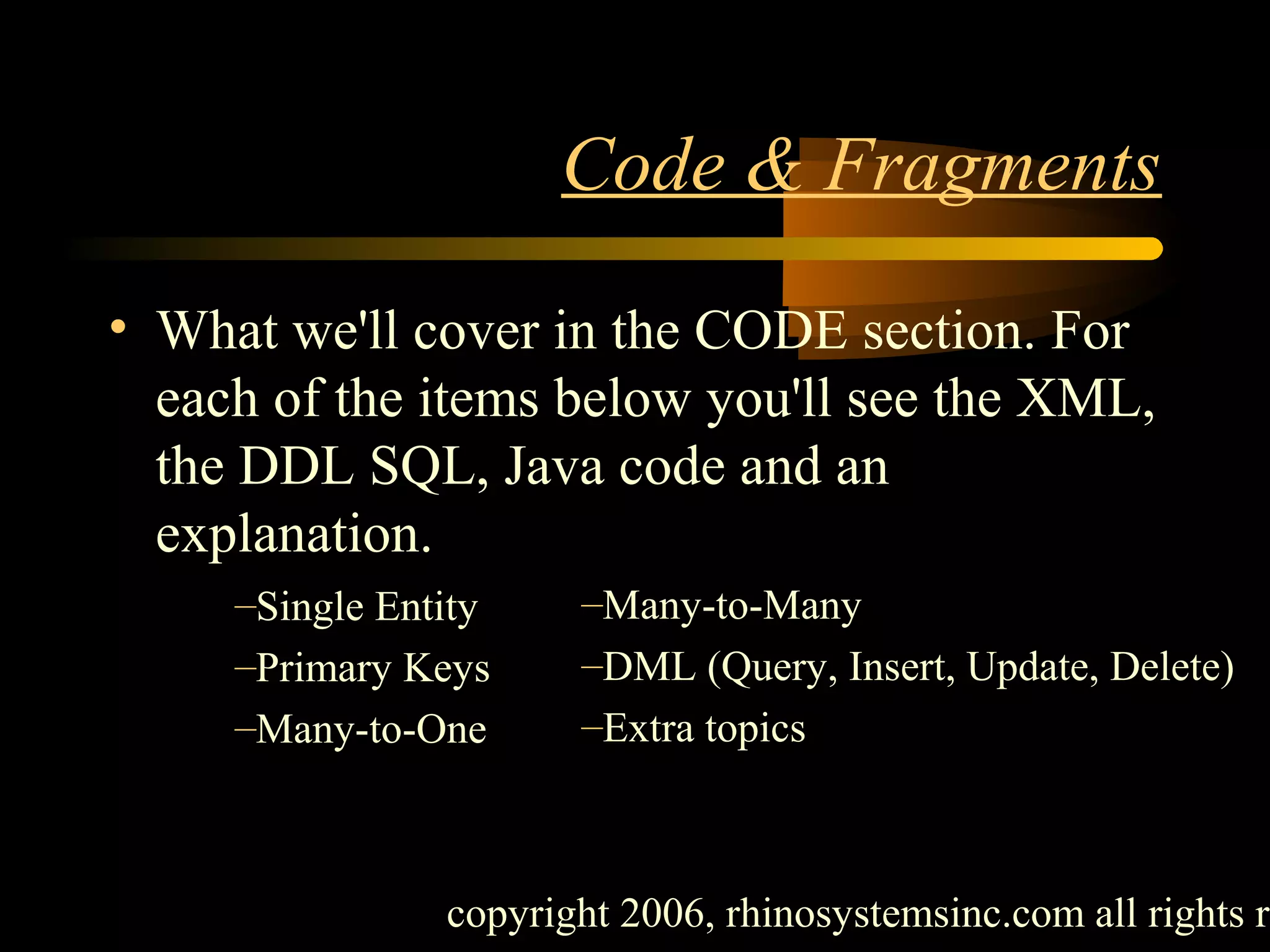
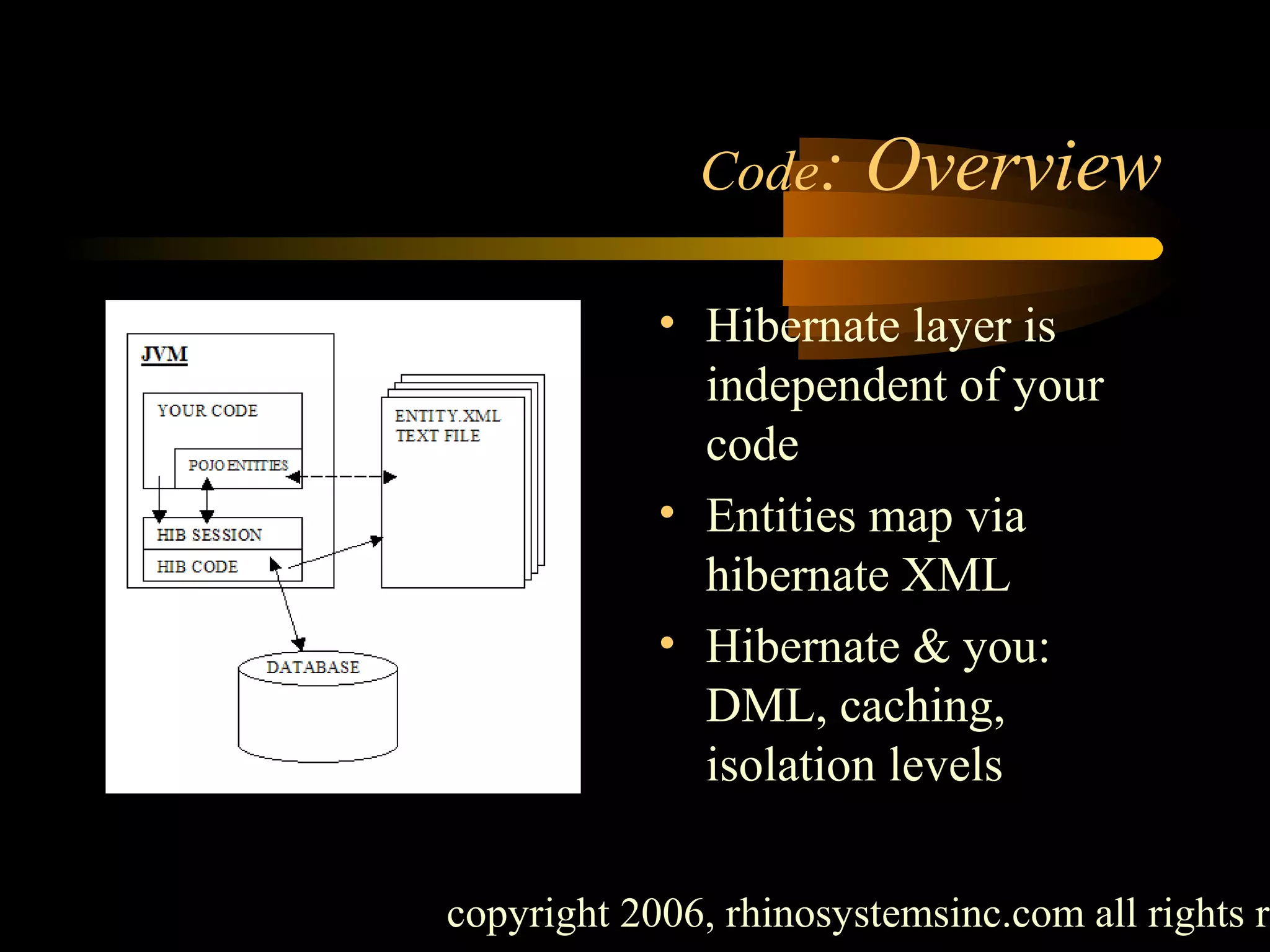
![copyright 2006, rhinosystemsinc.com all rights re
Code[0]: Java POJO Entity
public class Person {
Long PERSON_ID=null; //manufactured surrogate key
String FIRST_NAME=null;
String LAST_NAME=null;
public Long getPERSON_ID(){…}
public void setPERSON_ID(String) {…}
public String getFIRST_NAME(){…}
public void setFIRST_NAME(String) {…}
public String getLAST_NAME(){…}
public void setLAST_NAME (String) {…}
}
See SAMPLE 0
1/4
Standard get/set &
need empty
constructor ~](https://image.slidesharecdn.com/hibernatejavaandoracle1-151018162037-lva1-app6892/75/Hibernate-java-and_oracle-16-2048.jpg)
![copyright 2006, rhinosystemsinc.com all rights re
Code[0]: XML for Entity
<!--Must be named: Person.hbm.xml and reside in CLASSPATH-->
<?xml version="1.0" encoding="UTF-8"?>
<!DOCTYPE hibernate-mapping PUBLIC "-//Hibernate/Hibernate Mapping DTD 3.0//EN" "http://hibernate.sourceforge.net/hibernate-mapping-3.0.dtd">
<hibernate-mapping>
<class name="com.rhinosystemsinc.hibernate.samples_0.Person" table="SAMPLE0_Person" >
<id name="PERSON_ID" column="PERSON_ID" type="java.lang.Long" unsaved-value="null">
<generator class="hilo">
<param name="table">SAMPLE0_PERSON_SEQ</param>
<param name="column">NEXT</param>
</generator>
</id>
<property
name="FIRST_NAME"
type="java.lang.String"
update="true"
insert="true"
column="FIRST_NAME"
not-null="true"
unique="false"
length="100"
/>
<property name="LAST_NAME"/>
</class>
</hibernate-mapping>
2/4
<?xml version="1.0" encoding="UTF-8"?>
<!DOCTYPE hibernate-mapping PUBLIC "-//Hibernate/Hibernate Mapping DTD 3.0//EN" "http://hibernate.sourceforge.net/hibernate-mapping-3.0.dtd">
<hibernate-mapping>
<id name="PERSON_ID" column="PERSON_ID" type="java.lang.Long" unsaved-value="null">
<generator class="hilo">
<param name="table">SAMPLE0_PERSON_SEQ</param>
<param name="column">NEXT</param>
</generator>
</id>
Define the manufactured
surrogate primary key,
based on SEQUENCE.
Also natural composite
primary keys:
<composite-id>
<key-property
name="name"/>
<key-property
name="ssn"/>
</composite-id>
<property
name="FIRST_NAME"
type="java.lang.String"
update="true"
insert="true"
column="FIRST_NAME"
not-null="true"
unique="false"
length="100"
/>
<property name="LAST_NAME"/>](https://image.slidesharecdn.com/hibernatejavaandoracle1-151018162037-lva1-app6892/75/Hibernate-java-and_oracle-17-2048.jpg)
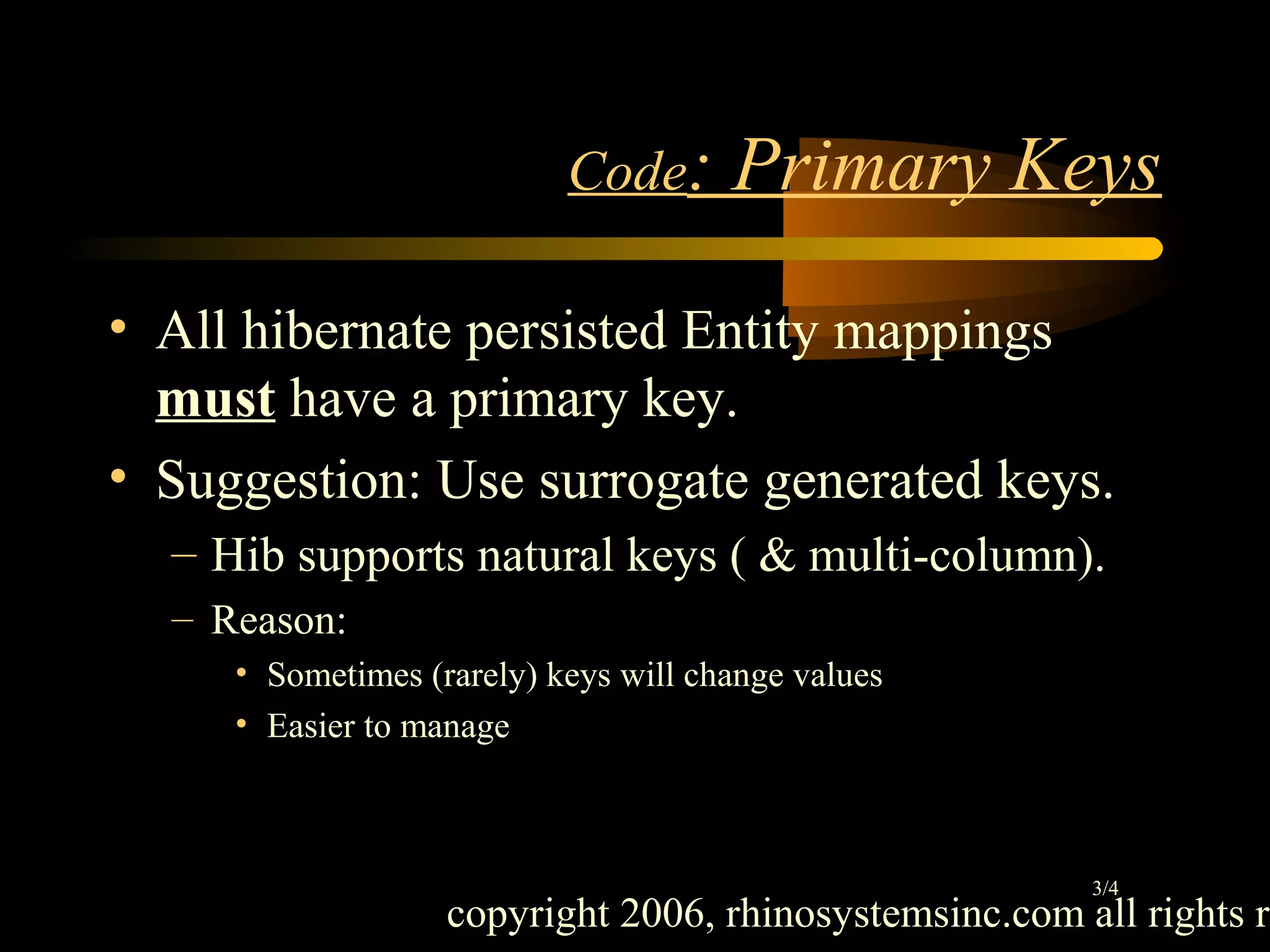
![copyright 2006, rhinosystemsinc.com all rights re
Code[0]: Java Main Class
//SAVING A NEW OBJECT
org.hibernate.Session sess = sessFact.openSession(); //more on SessionFactory in a minute.
Person p = new Person();
p.setFIRST_NAME("John");
p.setLAST_NAME("Smith");
Transaction tx = sess.beginTransaction();
sess.saveOrUpdate(p);
tx.commit();
sess.close();
See SAMPLE 0
At this point, what if we do an
update, via SQLPLUS?
4/4](https://image.slidesharecdn.com/hibernatejavaandoracle1-151018162037-lva1-app6892/75/Hibernate-java-and_oracle-19-2048.jpg)
![copyright 2006, rhinosystemsinc.com all rights re
Code[0]: Java 1-to-Many
public class Person {
Long PERSON_ID=null; //manufactured surrogate key
String FIRST_NAME=null;
String LAST_NAME=null;
Set ADDRESSES=null;
public Set getADDRESSES()
{
return ADDRESSES;
}
public void setADDRESSES(Set ADDRESSES)
{
this.ADDRESSES = ADDRESSES;
}
…//rest of get/set methods
}
NEW](https://image.slidesharecdn.com/hibernatejavaandoracle1-151018162037-lva1-app6892/75/Hibernate-java-and_oracle-20-2048.jpg)
![copyright 2006, rhinosystemsinc.com all rights re
Code[0]: Person XML 1-to-Many
…
<hibernate-mapping>
<class name="com.rhinosystemsinc.hibernate.samples_0.Person" table="SAMPLE0_Person" >
…
<set
name="ADDRESSES"
lazy="false"
inverse="true"
cascade="save-update"
sort="unsorted"
outer-join="true">
<key column="PERSON_ID"/>
<one-to-many class="com.rhinosystemsinc.hibernate.samples_1.Address"/>
</set>
…
</class>
</hibernate-mapping>
NEW
Any records that don't have address will be shown too.
all or save-update-delete
Notice one-to-many ~](https://image.slidesharecdn.com/hibernatejavaandoracle1-151018162037-lva1-app6892/75/Hibernate-java-and_oracle-21-2048.jpg)
![copyright 2006, rhinosystemsinc.com all rights re
Code[0]: Java 1-to-Many
public class Address {
Long ADDRESS_ID=null;
String STREET=null;
String APT_NO=null;
String CITY=null;
String STATE=null;
String ZIP=null;
Person person=null;// the person this address belongs to.
public Person getPerson()
{
return person;
}
public void setPerson(Person person)
{
this.person = person;
}
…//rest of get/set methods
}
New Address class
Person reference ~
See Sample 1](https://image.slidesharecdn.com/hibernatejavaandoracle1-151018162037-lva1-app6892/75/Hibernate-java-and_oracle-22-2048.jpg)
![copyright 2006, rhinosystemsinc.com all rights re
Code[0]: Address XML 1-to-Many
…usual header
<class name="com.rhinosystemsinc.hibernate.samples_1.Address"
table="SAMPLE1_Address" dynamic-update="true">
<id name="ADDRESS_ID" column="ADDRESS_ID"
type="java.lang.Long" unsaved-value="null">
<generator class="sequence">
<param name="sequence">SAMPLE1_ADDRESS_SEQ</param>
<param name="parameters">INCREMENT BY 1 START WITH 1</param>
</generator>
</id>
<many-to-one name="person" class="com.rhinosystemsinc.hibernate.samples_1.Person"
cascade="save-update"
fetch="join"
lazy="false"
update="true"
insert="true"
column="PERSON_ID"
not-null="false"/>
…rest of properties defined
Address class
NOTICE different
definition sample of
the sequence
will always be
eagerly fetched.
~
For outer-join fetching or use 'select'
sequential select fetching. N+1 select prob.
Notice variable name in Address class
See Sample 1](https://image.slidesharecdn.com/hibernatejavaandoracle1-151018162037-lva1-app6892/75/Hibernate-java-and_oracle-23-2048.jpg)
![copyright 2006, rhinosystemsinc.com all rights re
Code[0]: main 1-to-Many
public static void main(String args[])
….
Address addr = new Address();
Person p = new Person();
p.setFIRST_NAME("John");
p.setLAST_NAME("Thompson");
p.setADDRESSES(new HashSet());
p.getADDRESSES().add(addr);
p.setCreated(new Date());
addr.setSTREET("12345 Easy");
addr.setCITY("Sacramento");
addr.setSTATE("CA");
addr.setORDER_POS(new Long(1));
addr.setCreated(new Date());
addr.setPerson(p);
…
sess.save(p);
tx.commit();
…
…
See Sample 1
assign person reference to address ~
Create an empty "set" and assign to Person
Add the address to the "set"](https://image.slidesharecdn.com/hibernatejavaandoracle1-151018162037-lva1-app6892/75/Hibernate-java-and_oracle-24-2048.jpg)
![copyright 2006, rhinosystemsinc.com all rights re
Code[0]: Java Many-to-Many
public class Address {
…same as before
Set persons=null;// the person this address belongs to.
public Set getPersons()
{
return persons;
}
public void setPersons(Set persons)
{
this.persons = persons;
}
…//rest of get/set methods
}
NEW ~
See Sample 2](https://image.slidesharecdn.com/hibernatejavaandoracle1-151018162037-lva1-app6892/75/Hibernate-java-and_oracle-25-2048.jpg)
![copyright 2006, rhinosystemsinc.com all rights re
Code[0]: XML Many-to-Many
…usual header
<class name=...Address>
<set name="persons"
table="SAMPLE2_PERSON_ADDRESS">
<key column="ADDRESS_ID"/>
<many-to-many
class="com.rhinosystemsinc.hibernate.samples_2.Person"
column="PERSON_ID"/>
</set>
…rest of properties defined
</class>
</hibernate-mapping>
"Set persons=null" in java
See Sample 1
Intermediate M-M table
M-M definition,
referencing the Person
class by PERSON_ID
~](https://image.slidesharecdn.com/hibernatejavaandoracle1-151018162037-lva1-app6892/75/Hibernate-java-and_oracle-26-2048.jpg)
![copyright 2006, rhinosystemsinc.com all rights re
Code[0]: Main Many-to-Many
Address addr = new Address();
Person p = new Person();
p.setFIRST_NAME("John");
p.setLAST_NAME("Thompson");
p.setADDRESSES(new HashSet());
p.getADDRESSES().add(addr);
p.setCreated(new Date());
addr.setSTREET("12345 Easy");
…
//revised! for many-to-many
addr.setPersons(new HashSet());
addr.getPersons().add(p);
//ADD NEW PERSON TO ADDRESS
Person p2=new Person();
p2.setFIRST_NAME("Martha");
p2.setLAST_NAME("Thompson");
p2.setADDRESSES(new HashSet());
p2.getADDRESSES().add(addr);
addr.getPersons().add(p2);
See Sample 1
Create empty list of Addresses
Martha also lives at the SAME address,
here we add the address to the p2 object ~
Setup empty Address and Person object](https://image.slidesharecdn.com/hibernatejavaandoracle1-151018162037-lva1-app6892/75/Hibernate-java-and_oracle-27-2048.jpg)
![copyright 2006, rhinosystemsinc.com all rights re
Code[0]: Reference Data
• Data that doesn't change usually loaded at system
installation time. (Use 2nd
level Cache).
– Examples: STATES, CATEGORY, ZIP..etc.
• Strategy
– Setup XML class with element cache as read-only
– Setup cache for relation as read-only
– Call a method to load All read-only objects at
initialization (actually even everytime).
(for example…)](https://image.slidesharecdn.com/hibernatejavaandoracle1-151018162037-lva1-app6892/75/Hibernate-java-and_oracle-28-2048.jpg)
![copyright 2006, rhinosystemsinc.com all rights re
Code[0]: Reference Data
…
<class name="com.rhinosystemsinc.sample.Event">
…
<many-to-one
name="CATEGORY"
class="com.rhinosystemsinc.sample.Category"
cascade="none"
update="false"
insert="false"
column="CATEGORY_ID"
not-null="true" />
</class>
For the EVENT class
which operations should be cascaded from
the parent object to the associated object
Variable name for java class
Category CATEGORY=null;
We will not update or insert from this relationship. ~](https://image.slidesharecdn.com/hibernatejavaandoracle1-151018162037-lva1-app6892/75/Hibernate-java-and_oracle-29-2048.jpg)
![copyright 2006, rhinosystemsinc.com all rights re
Code[0]: Reference Data
…
<class name="com.rhinosystemsinc.sample.Category" mutable="false">
<cache usage="read-only" />
…
</class>
----------------------------------------------------------------------------------------------------------
In your Java code, load the objects at least once…
…
org.hibernate.Query q = sess.createQuery("from Category");
q.setCacheMode(org.hibernate.CacheMode.NORMAL);
q.setCacheable(true);
java.util.List result = q.list();
…
For the CATEGORY class
Set cache to be read-only
Also - notice no need for a reference back to Event class
Make sure your Query sets up the CACHING! (2nd
level) ~](https://image.slidesharecdn.com/hibernatejavaandoracle1-151018162037-lva1-app6892/75/Hibernate-java-and_oracle-30-2048.jpg)
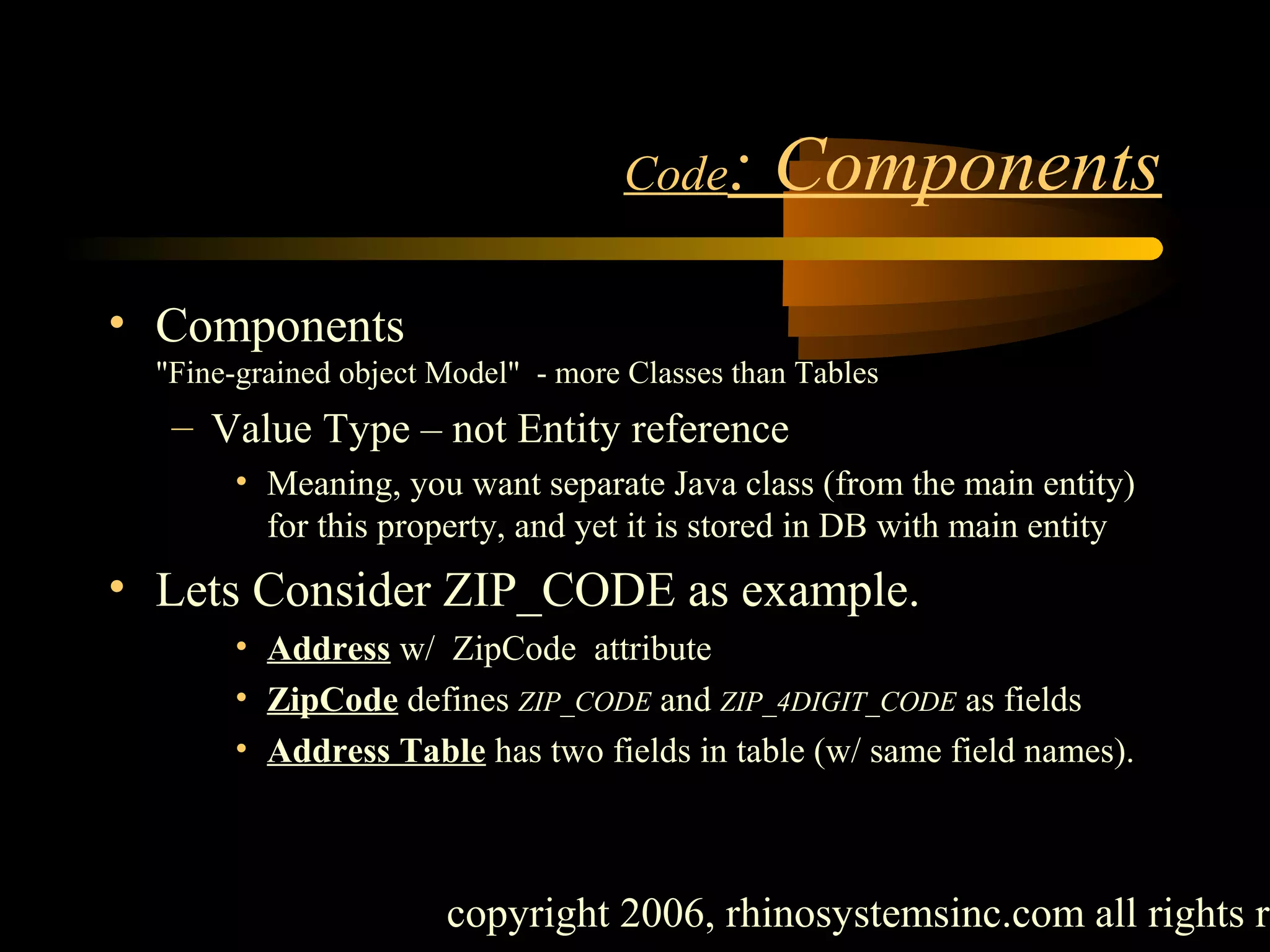
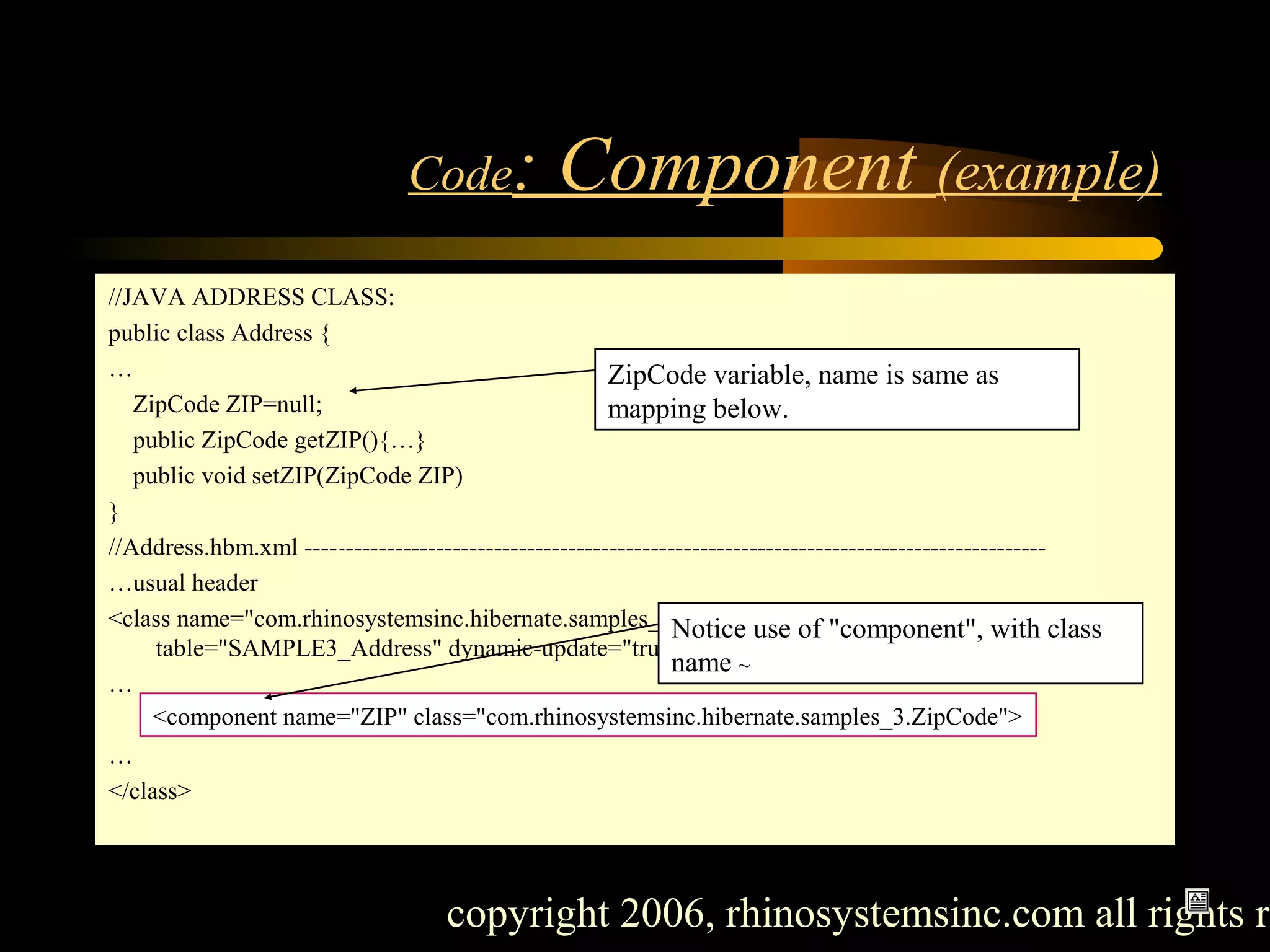
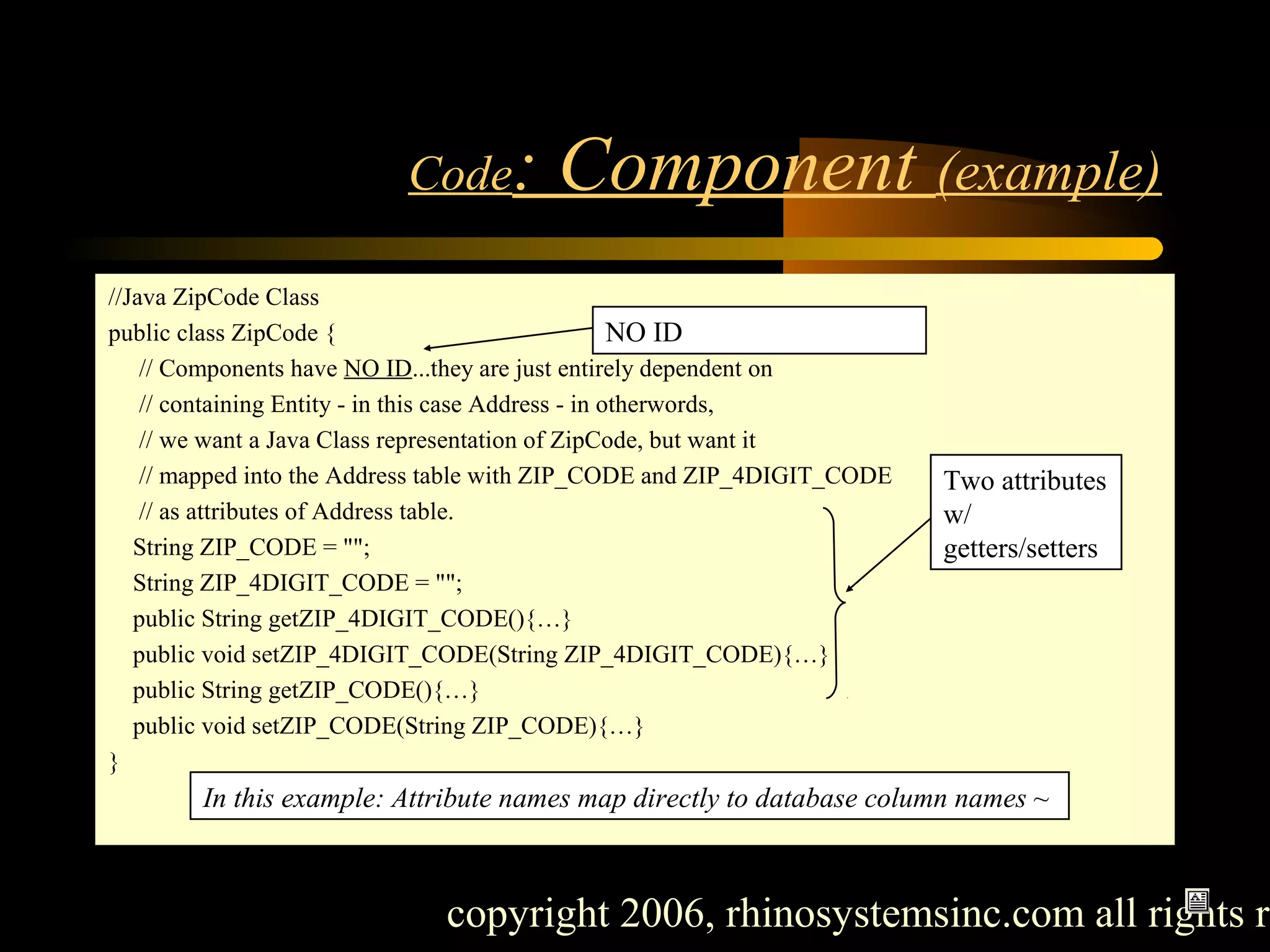
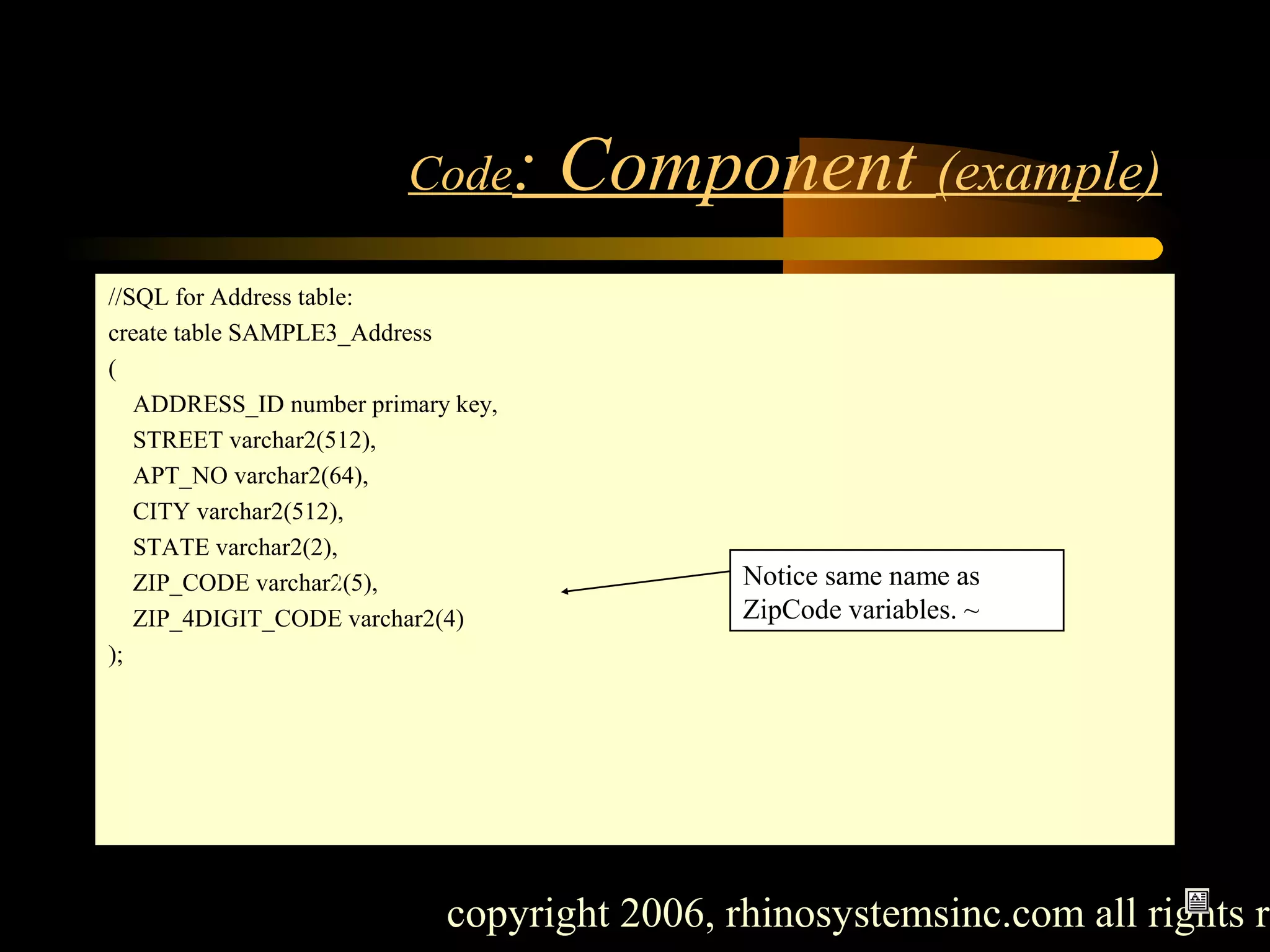
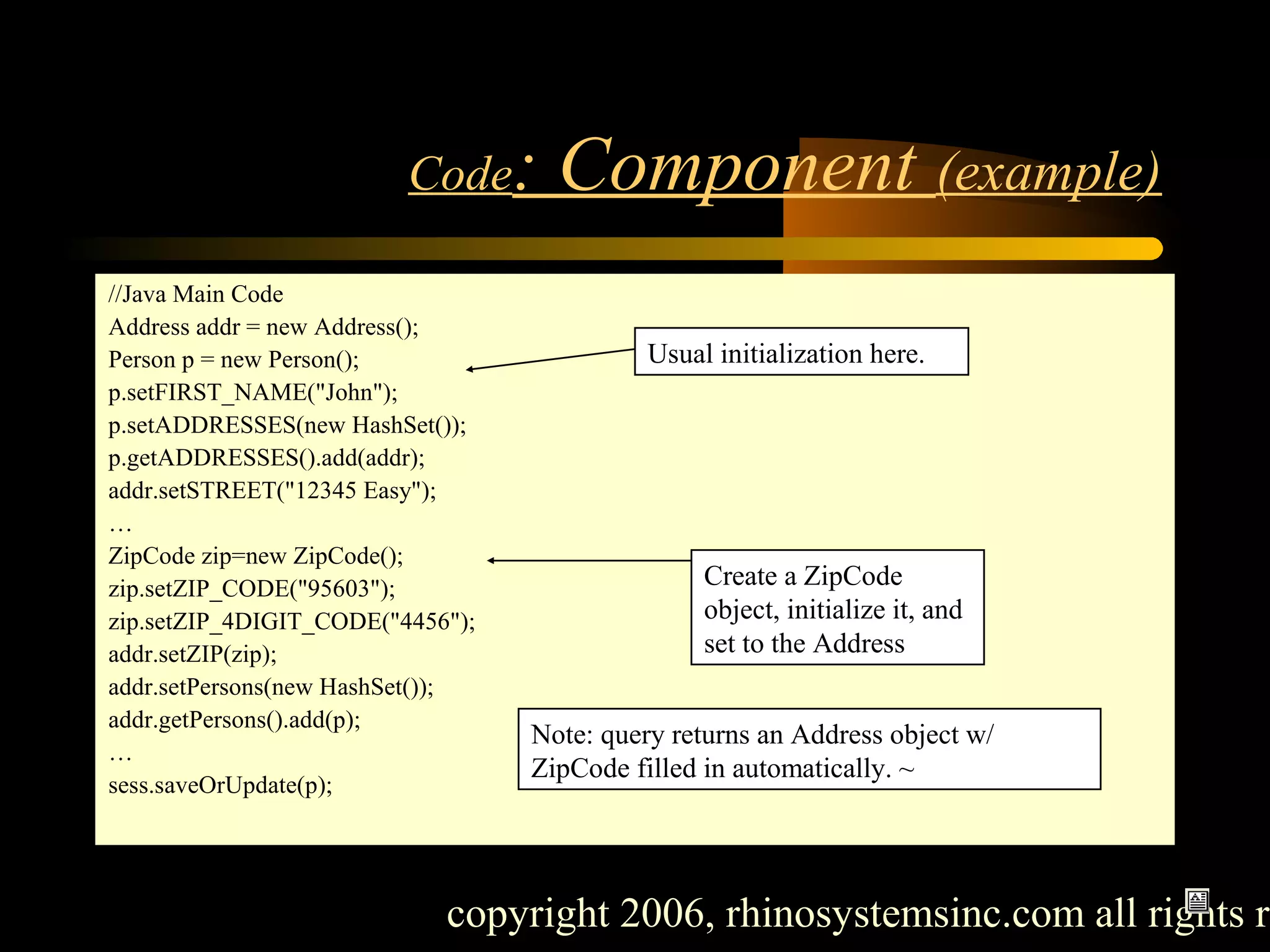
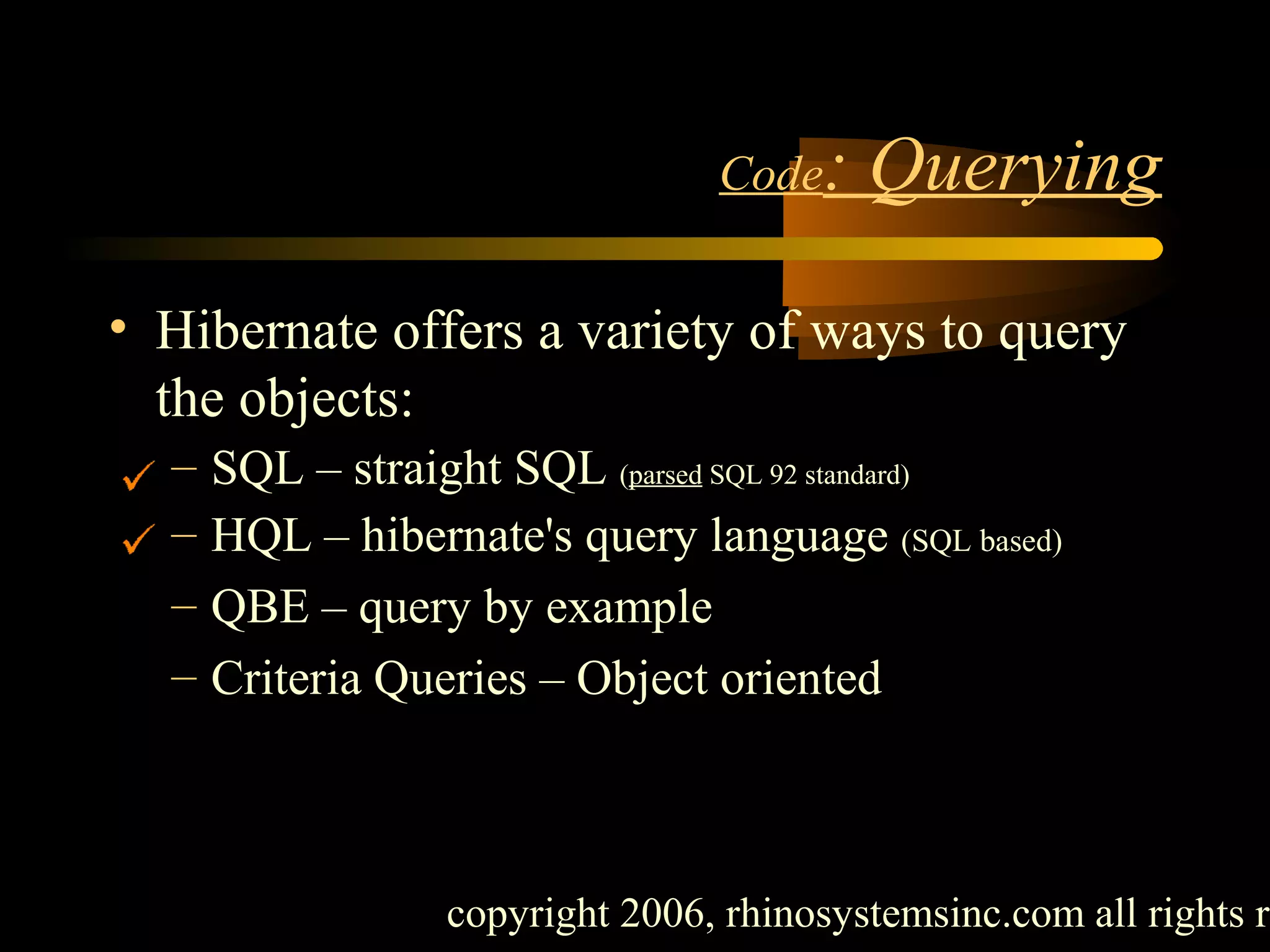
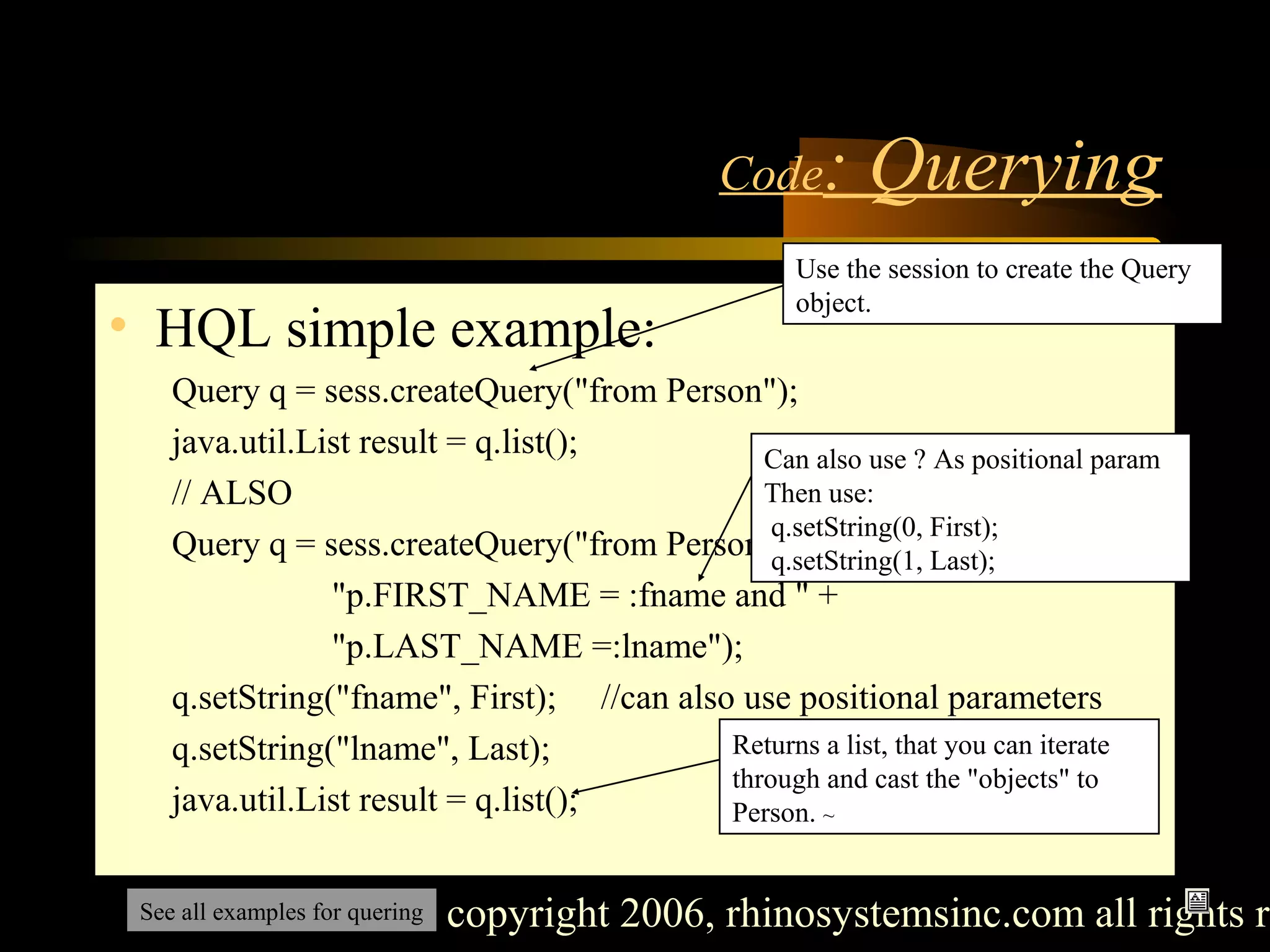
![copyright 2006, rhinosystemsinc.com all rights re
Code: Querying
• HQL scalar example (from reference.pdf):
Iterator results = sess.createQuery(
"select cat.color, min(cat.birthdate),
count(cat) from Cat cat " +
"group by cat.color").list().iterator();
while ( results.hasNext() )
{
Object[] column = (Object[]) results.next();
Color type = (Color) column[0];
Date oldest = (Date) column[1];
Integer count = (Integer) column[2];
.....
}
See all examples for quering
Notice alias "cat" lowercase
Notice cast – same as attribute
declared in Cat class ~](https://image.slidesharecdn.com/hibernatejavaandoracle1-151018162037-lva1-app6892/75/Hibernate-java-and_oracle-38-2048.jpg)
